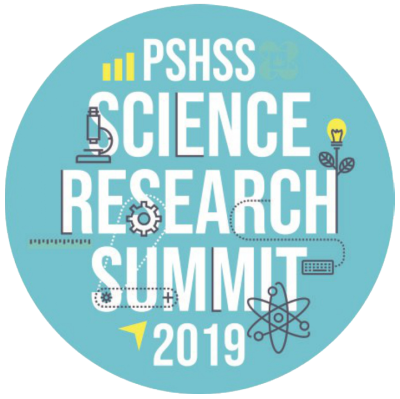

PSHS System Science Research Summit 2019
Congratulations to the winners of dost-pshs science research summit 2019.
CAPPING OFF THIS YEAR’S SCIENCE RESEARCH SUMMIT, the PSHS System recognises the hard work and diligence of the scholars in conducting their researches. After a meticulous deliberation among judges, the winners were concluded and announced on August 30, after the community fair.
3rd Place – Identification of candidate transcriptomic markers for the prognostication of Leptospirosis related complications (Feliz, Reneez Aiyana G.; Lipa, Aubrey Mae D – Main Campus)
2nd place – Genotyping of PTRVs for potential sources of Novel Tungro Resistance Genes (Medilla, Djoey Bianca C. – Main Campus)
1st Place – Diversity of Mangrove Foliar Endophytic Fungi from Matalom, Leyte (Costillas, Gwyneth Vera M.; Hillario, Tricia May T.; Mascariñas, Rian Lorenzo V. – Eastern Visayas Campus)
3rd Place – Tinospora crispa Leaf powder and Jatropha curcas Wood Ash against Sitophilus oryzae (Chio, Reigna Maxine W.; Gulles, Jane M.; Illustrisimo, Chrizha C.; Gabais, Cyrene B. – SOCCSKSARGEN Region Campus)
2nd Place – Polyaniline-based Putrescine Sensor through Digital Imaging Colorimetry (Mejares, Sadao Jr.; Paguio, Nicky Mariele M.; Roque, Joseph Ronald S. – Central Luzon Campus)
1st Place – Alternative Pharmaceutical Liquid Preservative from Tamarindus indica (Tamarind) Pulp Extracts (Aglugub, Marian Maxine W.; Padillo, Anne Felize P.; Villena, Julianne Jesh D. – Southern Mindanao Campus)
COMPUTATIONAL SCIENCE
3rd Place – Portable Arduino-based Integrated Water Quality Analyzer with Real-time Data Transmitter (Alave, Estelle Nicole L.; Lim, Harvey Andrew G.; Ronquillo, Jericho L,; Tugade, Marjun M. – SOCCSKSARGEN Region Campus)
2nd Place – Development of an iOS Application for Real-Time Spectral Classification of Stars Based on a Convolutional Neural Network (De los Santos, Mark John Paul M.; Evangelista , Paul Emmanuel D.; Ordonio, Juan Samuel A. – Main Campus)
1st Place – Machine-Learning Based Rainfall-induced Landslide Prediction System for Benguet First Engineering District (Tuguinay, Nica Magdalena A.; Omadiao, Zanya Reubenne D.; Saturay, Ricardo Jr. M – PSHS-Cordillera Administrative Region Campus)
ENGINEERING
3rd Place – Development of Cacao Seed Depulper (Arcilla, Jed C.; Imperial, Jerome C.; Penetrante, Joben Peter R. – Bicol Region Campus)
3rd Place – Project WaFLE: Development of an Arduino-based Water Flow and Level Encoder (Gonzaga, Hans; Adel, Jhoe; Kempis, Joshua – Eastern Visayas Campus)
2nd Place – Project LINIS: onLine waste management Integration of a Network of Interconnected Systems (Osorio, Justin Benedict R. – Central Visayas Campus)
1st Place – Development of a Mahogany (Swietenia macrophylla) Seed-Inspired Horizontal-axis Wind Turbine (Gonzales, Kaira Maxine V.; Javier, Timothy L.; Marquez, John Henry T.; Tuazon, Alejandro Jose A. – Main Campus)
ENVIRONMENTAL SCIENCE 3rd Place – Macroinvertebrate Assessment and Stable Isotope Investigation of Mussels from Lake Danao, Ormoc (Elias, Remy Annen T.; Llave, Ara Marie C.; Rentuaya, Elejune Ace B. – Eastern Visayas Campus)
3rd Place – Tree Diversity, Aboveground Biomass, and Carbon Analysis in the Mangrove Forest of Brgy. Luna, San Jose, Dinagat Islands (Ajoc, Ronnie Rey D.; Asotigue, Carl Marlo D.; Epanes, Elejune Ace B. – CARAGA Region Campus)
3rd Place – Chlorella vulgaris Chlorophyll a Fluorescence as a Potential Biomaker for Zinc Detection (Cabanlig, Lydia Vittoria T.; Gepte, Bianca Victoria P.; Taguba, Mira Nicole J. – Main Campus)
2nd Place – Human Population Density Effects on the Variability of δ 15N and δ 13C of Seagrasses in Tacloban City, Philippines (Tomacas, Leila L.; Boonrayat, Vic Dam S.; Garay, Ysabela Denise P. – Eastern Visayas Campus)
1st Place – Composition, Abundance and Diversity of Zooplankton in Sarangani Bay, Sarangani Province (Cañete, Jeter Q.; Estrella, Noreen Joyce M.; Madelo, Yedda Sachi Patrice B.; Requeiron, Elani A. – SOCCSKSARGEN Region Campus)
MATERIALS SCIENCE
3rd Place – Carbon-modified Photocatalytic Porous Concrete for Water Purification (Baluyo, Jeremy A.; Sumpay, John Mark Nouwen S.; Villarin, Princess Willen F. – Bicol Region Campus)
2nd Place – Characterization of (Solanun tuberosum) Potato – Red Cabbage (Brassica oleracea var. Capitata F. rubra) Composite Film for Intelligent Packaging Applications (Aquino, Mikaela Andrea Paula; Aquino, Patricia Nicole; Saljay, Erica Nicole – Southern Mindanao Campus)
1st Place – Feasibility of Circulating Fluidized Bed Coal Bottom Ash as a Clay Soil Conditioner (Diola, Bertrand Michael L.; Pre, Sophia Francesca B.; Ricaforte, Caithleen Anne U. – Main Campus)
DOST Pisay scholars banner innovative researches in health and environment-friendly packaging
Press Release-Pisay-SRS-2019-03
SUBIC BAY , Zambales – The importance of finding solutions to pressing health problems like dengue and cancer were the inspiration of most of the students from the Philippine Science High School who attended the 3 rd Science Research Summit from 28-30 August 2019 held in Subic, Zambales.
This year’s summit that carries the theme, “Breaking Gender Barriers through Science, Technology, and Innovation” is an annual event for the country’s top scholars to present their research papers on various fields like Biology, Chemistry, Computational Science, Material Science, Engineering, and Environmental Science.
During the technical poster presentation last 29 August, subject matter experts and judges were given the opportunity to ask further questions and it also served as an exhibit of innovative ideas of the students from different Pisay campuses all over the country.
Philippine Science High School-Cordillera Administrative Region Campus Grade 12 students Bryne Benedict C. Fawayan, Enna Gabrielle Marie A. Joven, and Patricia Bea E. Palaroan, all residing in Baguio City, thought of doing a research using one of the most abundant trees in the summer capital; the pine tree.
The title of their research project was, “The Efficiency of Pinus kesiya Needles in repelling Aedes aegypti Mosquitoes”. Their theory revolved on the idea that there were substances or properties in pine needles that can be potential mosquito repellent.
“When I was in elementary, we also had research with pine needles but it’s towards cockroaches, so naisip namin po na mas relevant naman po ngayon pag mosquitoes kasi tumataas ang dengue cases,” said Patricia Bea E. Palaroan.
Palaroan further said that based on the reports from the Department of Health (DOH), the incidence of dengue in CAR had increased by 100% that resulted in some casualties and that really became a problem in the area.
According to the students, they need to find a solution to the problem and so they proceeded with their research and lucky enough, they encountered less difficulty since the material they were working on was literally found everywhere in Baguio City. Further they said that their advisers and the DOH where they got their supplies were very helpful.
“For the pine needles, we collected both dried and fresh; the dried ones we just picked them up from the ground and the fresh ones we got from the trees,” said Bryne Benedict C. Fawayan.
On the other hand, Grade 12 students from the Philippine Science High School-Cagayan Valley Region campus, namely Hermogenes B. Chioco IV, Shantal D. Uy, and Shanelle Rio Andrea T. Sadama presented their research study about the possible pharmaceutical use of the Kudit or the Split Gill mushroom ( Schizophyllum commune ) for breast cancer.
According to the students, the said mushroom specie that is abundant in Sanchez Mira, Cagayan province in Northern Luzon is known to have antioxidant capacity and antidiabetic property.
The student-researchers considered the health problem of breast cancer where three out of 100 Filipino women will likely develop the disease in their lifetime according to data from the Department of Health in 2014. Also, the incidence of breast cancer patients becoming drug resistant to commercially available treatments is real, thus prompting researchers to find for an alternative treatment using natural ingredients.
“Yung mga studies na nakita po namin ay nagsasabi na mayroon silang (mushrooms) antioxidant, anti-breast cancer property, so why not na gawin siyang potential na anti-breast cancer agent, so we tested anti-breast cancer activity niya…nakita po namin sa results na nag-shrink siya gamit yun extract namin,” said Sadama.
Likewise, if the research is validated to be successful, it offers a great relief to cancer patients as well as offer great potential for increased agricultural productivity that will encourage farmers to grow mushrooms as another source of income.
In the field of materials science there was a research project that practically addresses two basic problems when it comes to the use of plastics; one is pollution and the other one is food safety when plastic is used for food packaging.
Student-researchers Mikaela Andrea Paula Aquino, Patricia Nicole Aquino, and Erica Nicole Saljay from the Southern Mindanao Campus in Davao conducted their experiment on potato to solve the problems connected to the use of plastics.
Their research work titled, “Characterization of (Solanun tuberosum) Potato – Red Cabbage (Brassica var. oleracea F. rubra) Composite Film for Intelligent Packaging Applications” is one of the 48 research papers that passed the screening and made the final cut.
“The primary problem we want to address is the issue of plastic pollution and aside from that we want to tackle the issue of food spoilage brought about food infection or more of the ingestion of spoiled food and with this package, we want to make it easier for people to see that this food is already spoiled without actually having to be in contact with the food, for food packaging po talaga ang goal namin ,” said Patricia Nicole Aquino.
The three-day event was held from 28-30 August 2019 at the Subic Bay Travelers Hotel and Convention Center inside the Subic Bay Freeport Zone in Subic, Zambales. The annual event is being conducted to encourage students in the STEM strand to actively work on research studies and strengthen their skills and acumen in doing basic research that will address specific problems of society.
The Philippine Science High School System is under the wings of the Department of Science and Technology. The campuses represented were those in Quezon City (Main campus), Ilocos Region in San Ildefonso, Ilocos Sur; Cagayan Valley Region in Bayombong, Nueva Vizcaya; Cordillera Administrative Region in Irisan, Baguio City; Central Luzon Region in Clark Freeport Zone, Angeles, Pampanga; CALABARZON Region in Sampaga, Batangas City, MIMAROPA Region in Odiongan, Romblon; Bicol Region in Goa, Camarines Sur; Western Visayas Region in Jaro District, Iloilo; Central Visayas Region in Argao, Cebu; Eastern Visayas Region in Palo, Leyte; Central Mindanao Region in Balo-I Lanao, del Norte; Southern Mindanao Region in Tugbok District, Davao City; SOCCSKSARGEN Region in Koronadal, South Cotabato; Caraga Region in Butuan City, Agusan del Norte; and Zamboanga Peninsula Region in Dipolog City, Zamboanga del Norte. (Rudy de Guzman, S&T Media Service)
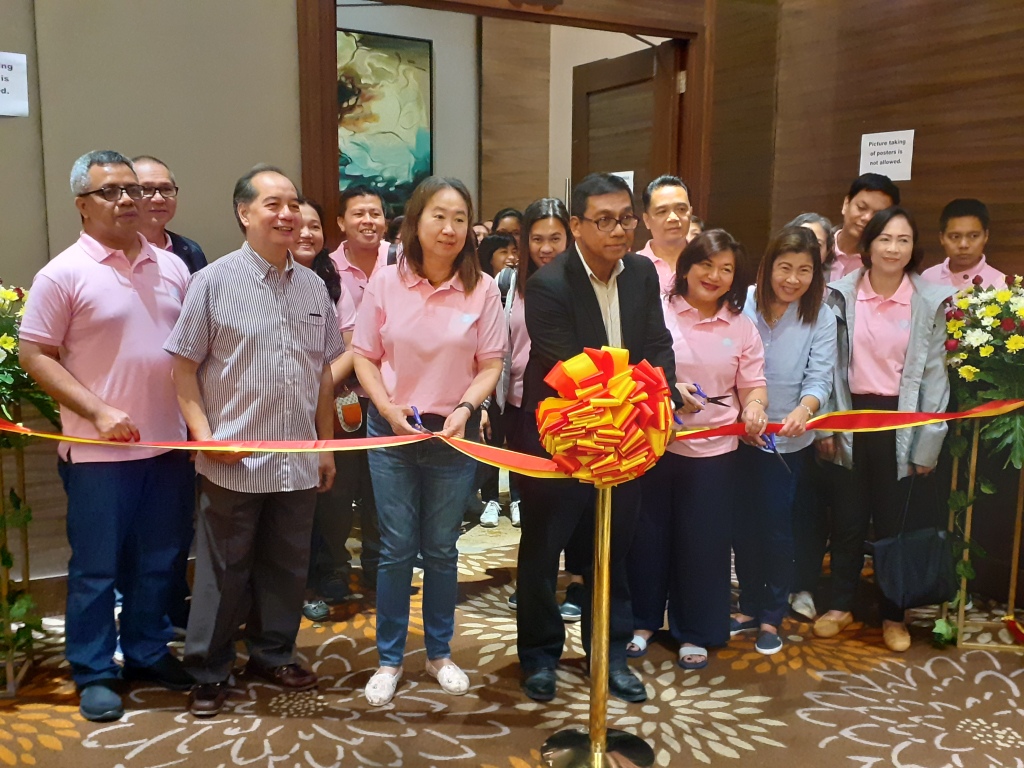
Building a culture of Science in Central Luzon
By Armi Flor Santos, PSHS
DESIGN THINKING WORKSHOP was conducted on August 29, during the DOST-PSHS Science Research Summit 2019 at Subic Bay Travelers Hotel. Building a culture of science is the aim of the PSHS in conducting community activities like this. In the design thinking workshop, aside from harnessing the younger PSHS scholars’ capacities in doing research, the PSHS teachers reached out to the communities to teach students from other schools in Central Luzon.
This workshop catered to 90 grade 10 scholars from the 16 PSHS campuses and 48 high school students from the Department of Education schools in Central Luzon. It was held in two sessions, morning and afternoon, and in two classes. PSHS Main Campus teachers Mr. Alejandro Jose A. Tuazon and Mr. Jejomar O. Bongat lectured about the basics of research, techniques, and strategies.
Research is part of the PSHS curriculum, taught in Grades 10-12. In grade 12, PSHS students refine their researches, and one way is by joining the science research summit. A panel of judges, comprised of field experts, critiques the scholars’ works through an oral and poster presentation. A second version of the research posters, re-designed to attract elementary students, are displayed for public viewing during the community fair.
The DOST-PSHS Science Research Summit 2019 wraps up on August 30 with a Community Fair, which is open to the public from 8:00 A.M. to 2.00 P.M. at Subic Bay Travelers Hotel.
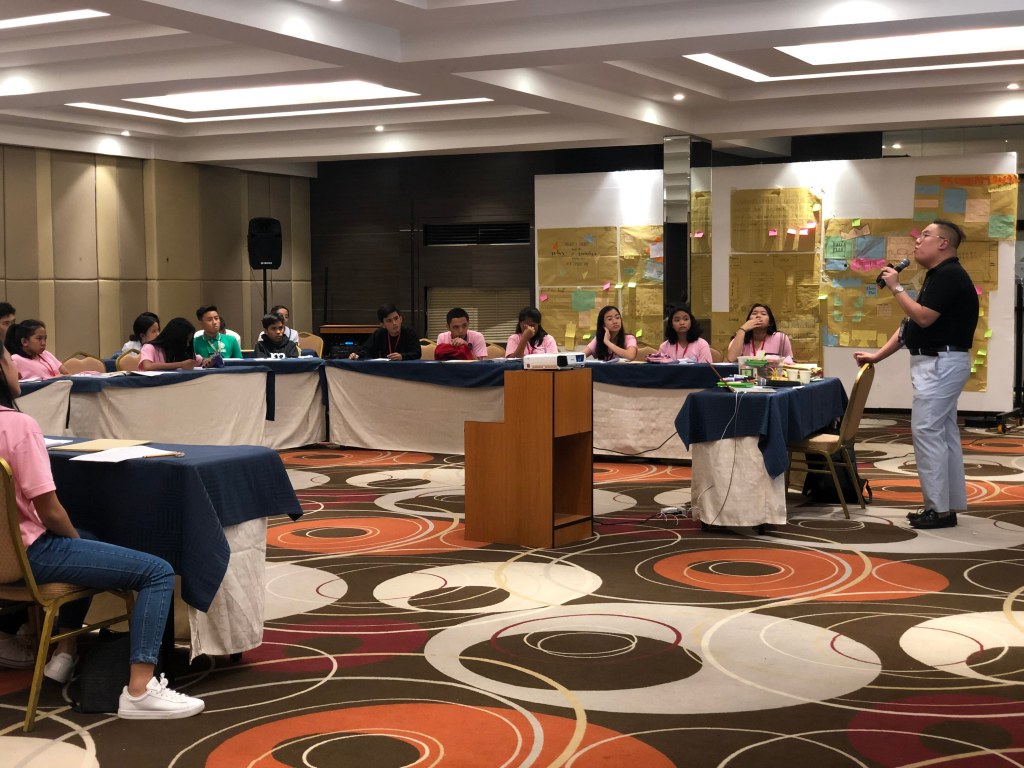
48 research projects ibinandera ng mga Pisay students
Balitang RapiDOST # 1-2019 Pisay SRS
By Rudy de Guzman, S&T Media Service
SUBIC BAY , Zambales — Kasalukuyang ginaganap sa Subic Bay, Zambales ang 3 rd Science Research Summit ng Philippine Science High School System kung saan may mahigit sa 200 mga matatalino at mga malikhaing estudyante ang magpapakitang gilas sa kanilang mga nagawang pananaliksik.
Ngayong araw, ika-29 ng Agosto ay magkakaroon ng Technical Poster Exhibit sa Verona Hall ng Subic Bay Travelers Hotel and Convention Center kung saan huhusgahan ng mga katangi-tanging mga hurado ang pinakamahusay na research project sa larangan ng Biology, Chemistry, Material Science, Environmental Science, Computational Science, at Engineering. May 130 research projects ang isinumite galing sa 13 Pisay campuses sa bansa na gawa ng mga Grade 12 students at 48 sa mga ito ang kasama sa summit.
Dito makikita ang mga iba’t-ibang research projects na ihahayag ang mga kakaibang nadiskubre na may pakinabang sa ating pamayanan. Ang ilan ditto ay ang mga sumusunod: ang pine needles at balat ng kalamansi na maaaring panlaban sa dengue; ang Kudit na isang uri ng kabute na posibleng maging panlaban sa breast cancer; ang paggamit ng napipiling mga herbs upang mapatagal ang shelf life ng mga karne; ang paggamit ng low-cost alert system para malaman ang mga lugar na madalas magkaroon ng landslide; at ang paggamit ng pili para mapatibay ang biodegradable plastic.
Ang naturang summit ay mayroon din Community Fair na gaganapin sa ika-30 ng Agosto kung saan masisilayan ng mga Grades 4-6 na mag-aaral sa elementarya mula sa mga eskwelahan sa rehiyon para sila rin ay mahimok na pagbutihin ang pag-aaral sa siyensya, teknolohiya at inobasyon.
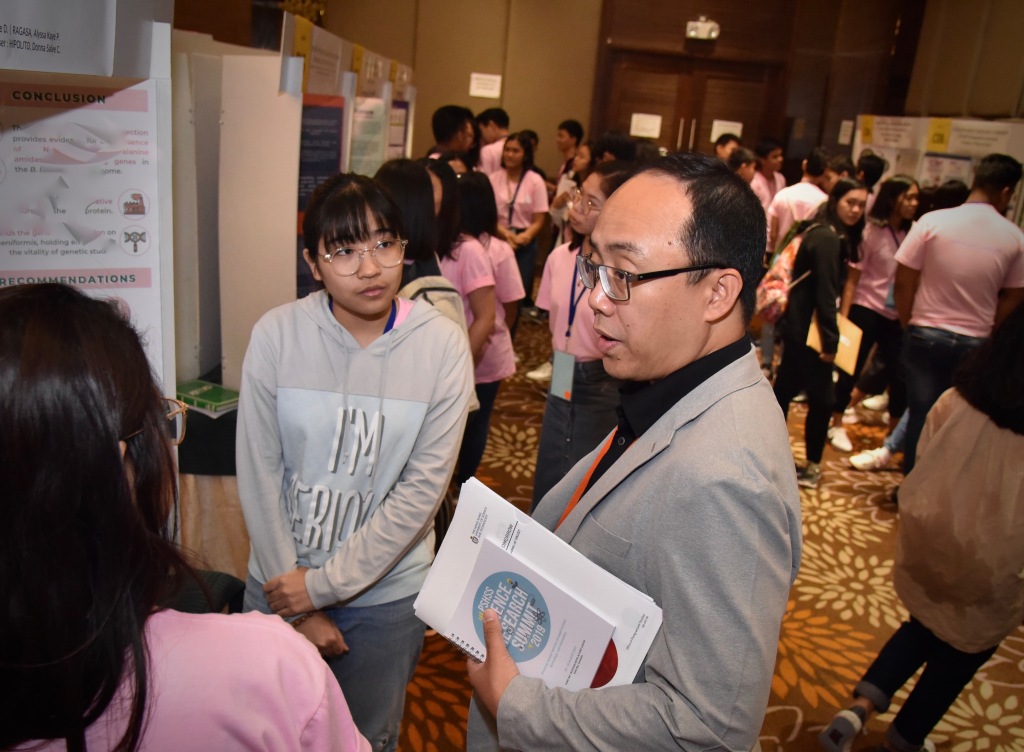
DOST, PSHS top brass emphasize thrust on creating S&T culture
By Harold V. Gallo, PSHS
“Hindi tayo nagpapaaral sa mga tao (scholars) para maging scientists or researcher lang, ang ating talagang gusto ay magkaroon ng science and technology culture sa lahat ng Pilipino”, thus said Dr. Renato U. Solidum, OIC – Office of the Undersecretary for Scientific and Technological Services, DOST emphasized in a press conference at the Subic Bay Travelers Hotel in Subic Bay Freeport Zone, Philippines, August 28, 2019 during the conduct of the Science Research Summit (SRS) of PSHS System.
Dr. Solidum emphasized that the culture of science should be appreciated and mainstreamed in all of the professions.
USEC Solidum also pointed that the main thrust of PSHS and DOST is to link the academe, government and industry, and activities like SRS is an exposure for the scholars to learn new knowledge.
USEC Solidum, Executive Director Ms. Lilia T. Habacon and regional campus directors heralded the contributions of PSHS to the nation citing their respective accomplishments.
Director Habacon said that among the 20,136 graduates since 1964, 98% enrolled in S&T courses but through time, some have changed careers.
She mentioned that some graduates became entrepreneurs and already providing employment to people.
“Yun ang dream namin for Philippine Science High School graduates that they provide employment to the Filipino people because of their exposure and opportunities and in turn sana po sila ay magprovide ng employment at hindi lang basta empleyado,” said Director Habacon.
She also mentioned that around 30% of graduates are working outside the country, some are working in government and others are in private sectors and in their own ways they contribute through exchange of technical knowhow, laboratories, and expertise, etc.
Dr. Solidum and Ms. Habacon cited that through the combined efforts of the government agencies including DOST and PSHSS, the Global Innovation Index of the Philippines improved from rank 73 to 54.
Anchored on its theme breaking gender barriers through science and technology and innovation, the 2019 SRS is hosted by PSHSS which featured best researches of PSHS scholars.
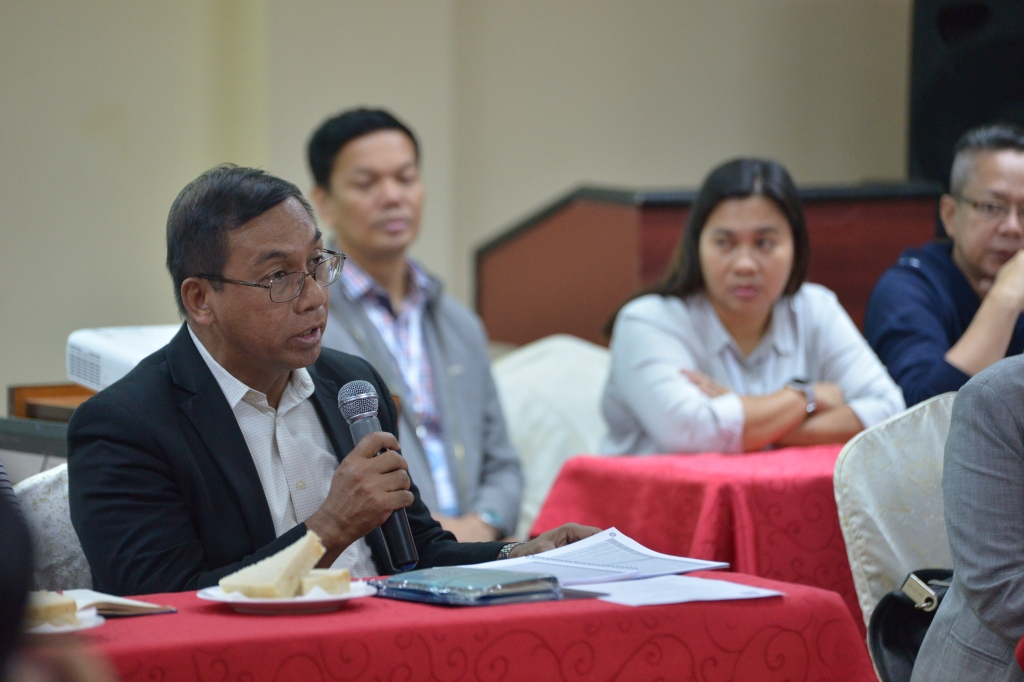
DOST’s fault finder Usec. Solidum, hinimok ang mga Pisay students na gumawa ng mga research projects na makabubuti sa komunidad
Balitang RapiDOST # 2-2019 Pisay SRS
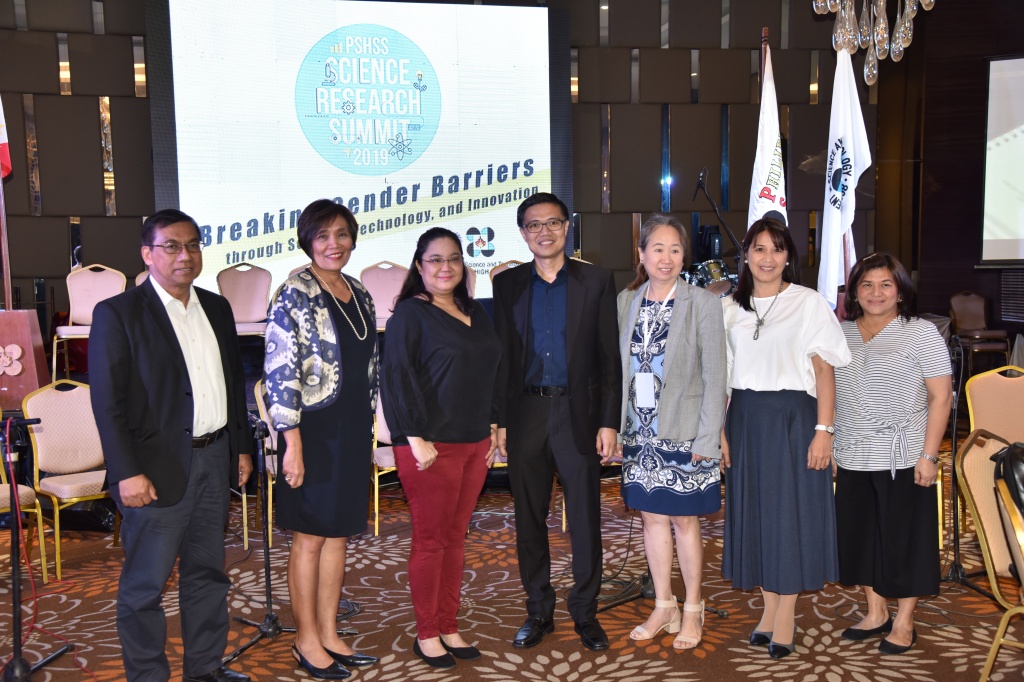
SUBIC BAY , Zambales – Sa kanyang mensahe sa may mahigit na 200 mag-aaral ng Philippine Science High School System sa 3 rd Science Research Summit ay hinimok ni Dr. Renato U. Solidum Jr., Undersecretary for Disaster Risk Reduction and Climate Change at OIC ng Office of the Undersecretary for Scientific and Technological Services ng Department of Science and Technology ang mga taga-Pisay na gumawa ng mga pananaliksik o research projects na makabubuti sa kalagayan ng mg lokal na komunidad.
Sinabi ni Usec. Solidum na gamitin ng mga mag-aaral sa Pisay ang kanilang angking talino sa siyensya, teknolohiya at inobasyon upang makagawa ng mga pananaliksik sa larangan ng biology, chemistry, engineering, material science, environmental science at computational science upang mapabuti ang pagsasaka at tumaas ang ani, ang pagdebelop ng mga environment-friendly na pang-araw-araw na mga kagamitan, mga lunas sa mga iba’t-ibang sakit, at mga paraan upang maging ligtas sa sakuna at kalamidad.
Ang naturang summit ay nagbukas noon ika-28 ng Agosto at tatagal hanggang ika-30 ng Agosto. Mayroon mga Technical Poster Exhibit sa Verona Hall ng Subic Bay Travelers Hotel and Convention Center. May 130 research projects ang isinumite galing sa 13 Pisay campuses sa bansa na gawa ng mga Grade 12 students.
Dito makikita ang mga iba’t-ibang research projects na ihahayag ang mga kakaibang nadiskubre na may pakinabang sa ating pamayanan. Ang ilan dito ay ang mga sumusunod: ang research sa paglaban sa dengue at leptospirosis gamit ang pine needles at balat ng kalamansi; ang Kudit na isang uri ng kabute na posibleng maging panlaban sa breast cancer; ang paggamit ng fish protein powder mula sa fish waste; paggamit ng kakaibang systema sa Metromanila railway network; at ang paggamit ng low-cost alert system para malaman ang mga lugar na madalas magkaroon ng landslide. (Article by Rudy de Guzman, S&T Media Service)
Be the next international Pinoy scientists, PSHS tells youth
In a press conference for DOST-PSHS Science Research Summit 2019 on August 28, DOST Undersecretary Renato U. Solidum tells media, “it’s not only about money, it’s about the contentment and how the community would feel your worth”.
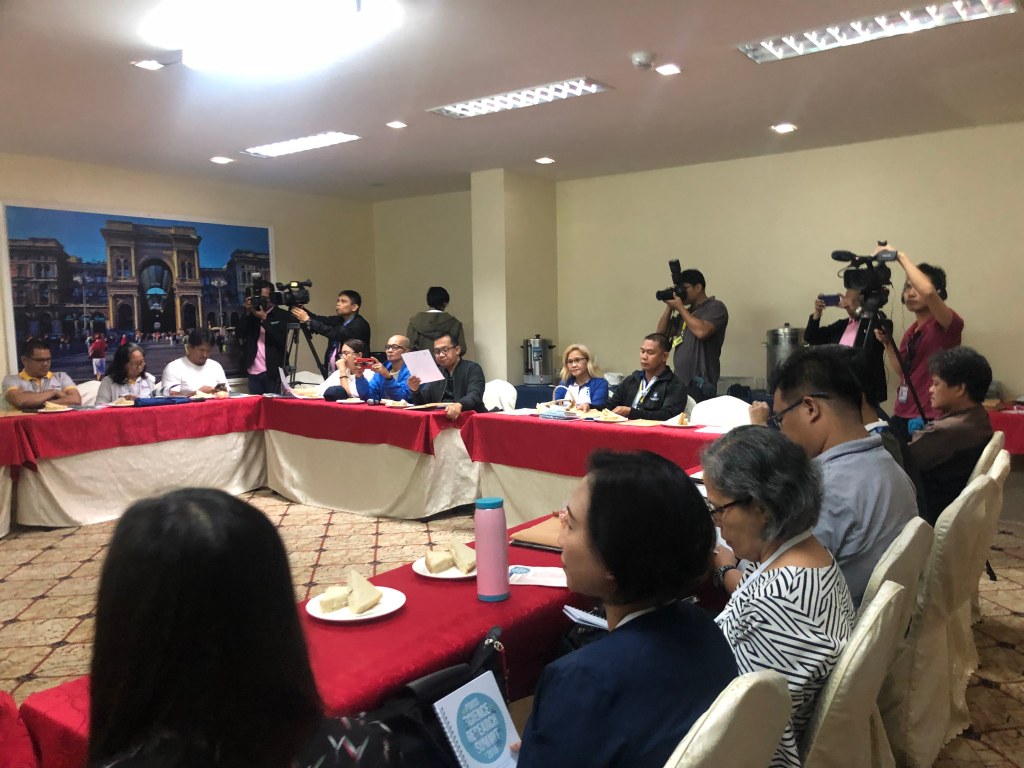
The DOST-PSHS System holds the Science Research Summit (SRS) 2019 at Subic Bay Travelers Hotel on August 28-30, with the aim to harness the scholars’ abilities in doing researches and to promote science to the communities. In line with intensifying its information campaign, the PSHS conducted a press conference on the first day of the summit, which convened communicators from DOST-Science and Technology Information Institute, Philippine Information Agency Region III and the local media in Central Luzon.
PSHS System executive director Lilia T. Habacon mentions that to date, PSHS has 20,136 graduates since its inception, and 98% of these graduates pursued science and technology (S&T) courses. She further mentioned, through time, some of these graduates became entrepreneurs, and provided employment to their fellow Filipinos.
Dr. Jessamyn Marie O. Yazon, Head of SRS 2019 and PSHS System chief science research specialist gave the press an overview of this summit while the PSHS campus directors took turns in introducing their respective campuses to the press.
As mandated by law, the PSHS System shall establish one campus in every region in the country. With this, the PSHS is able to extend its globally-competitive services to more Filipinos in the different parts of the country.
Executive Director Habacon announces that four regional campuses are accepting 120 scholars per year level: Central Luzon Campus in Clark Freeport Zone; CALABARZON Region Campus in Batangas City; Western Visayas Campus in Iloilo City; and Southern Mindanao Campus in Davao City. This increase in scholarship slots is brought about by the high number of applicants to these campuses every year.
Currently, the other 11 regional campuses accept 90 scholars per year level. PSHS is working towards increasing the number of scholarship slots in these campuses. Main Campus, the first PSHS campus which opened in 1964, accepts 240 scholars per year level.
PSHS is accepting applicants for Grade 7 in school year 2020-2021. Download the application form at www.pshs.edu.ph or visit any PSHS campuses/DOST offices/Provincial S&T offices nearest you. Deadline for filing of application is on 13 September 2019. Examination date is on 19 October 2019.
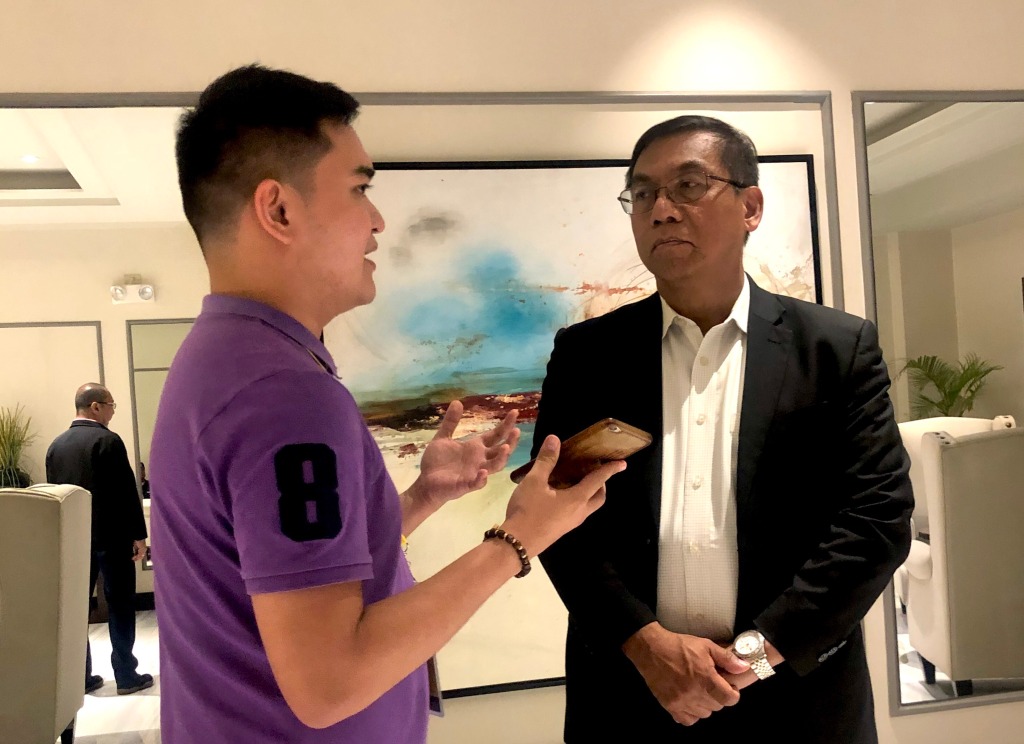
DOST PISAY SCHOLARS PARTICIPATE IN TEAM BUILDING ACTIVITIES DURING THE 3RD SCIENCE RESEARCH SUMMIT
By rudy de guzman, dost-science and technology information institute.
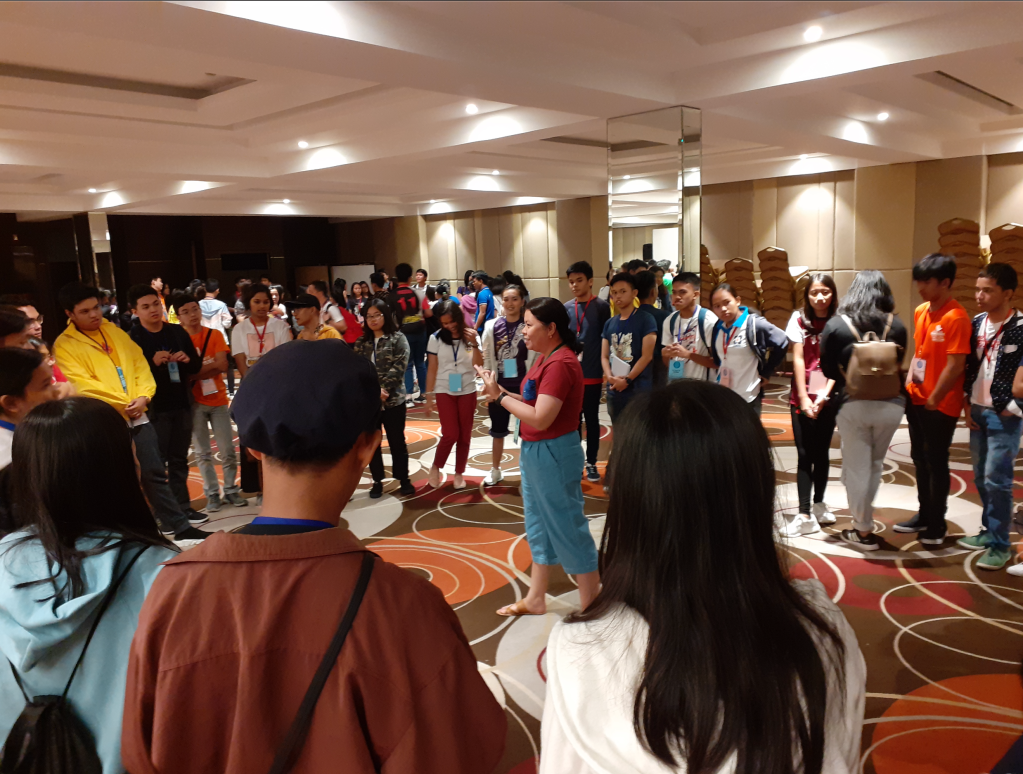
SUBIC BAY , Zambales – Some 226 Philippine Science High School (PSHS) scholars coming from all 16 regional campuses participated in the teambuilding activities of the 3 rd Science Research Summit (SRS) held on 27-30 August 2019 at the Subic Bay Travelers Hotel inside the Subic Bay Freeport Zone in Subic, Zambales.
The student-delegates were led by their teacher-chaperones during the pre-event activity where they were able to meet new friends from the different campuses, thus fostering stronger camaraderie among the future scientists.
This year’s summit that officially opens on 28 August 2019, carries the theme, “Breaking Gender Barriers through Science, Technology, and Innovation” where the country’s top scholars will present their research papers in the fields of Biology, Chemistry, Computational Science, Material Science, Engineering, and Environmental Science.
During the 3-day summit, the students will also mount an exhibit of their research works presented in two versions. The first will be the Technical Poster presentation on 29 August for the appreciation of the distinguished panel of judges while the second version will be the Community Fair Poster presentation on 30 August. The latter is a simpler version of the former presented with more colorful graphics and common words for viewing by Grades 4-6 students from the nearby schools in Subic and is also open to the general public.
The event will be capped by the awarding ceremony where the best research papers in each category will be given recognition with medals for the first, second and third placers.
The Philippine Science High School System is under the wings of the Department of Science and Technology. The campuses include those in Quezon City (Main campus), Ilocos Region in San Ildefonso, Ilocos Sur; Cagayan Valley Region in Bayombong, Nueva Vizcaya; Cordillera Administrative Region in Irisan, Baguio City; Central Luzon Region in Clark Freeport Zone, Angeles, Pampanga; CALABARZON Region in Sampaga, Batangas City, MIMAROPA Region in Odiongan, Romblon; Bicol Region in Goa, Camarines Sur; Western Visayas Region in Jaro District, Iloilo; Central Visayas Region in Argao, Cebu; Eastern Visayas Region in Palo, Leyte; Central Mindanao Region in Balo-I Lanao, del Norte; Southern Mindanao Region in Tugbok District, Davao City; SOCCSKSARGEN Region in Koronadal, South Cotabato; Caraga Region in Butuan City, Agusan del Norte; and Zamboanga Peninsula Region in Dipolog City, Zamboanga del Norte. (S&T Media Service)
PSHS scholars prep up for science research summit in Subic
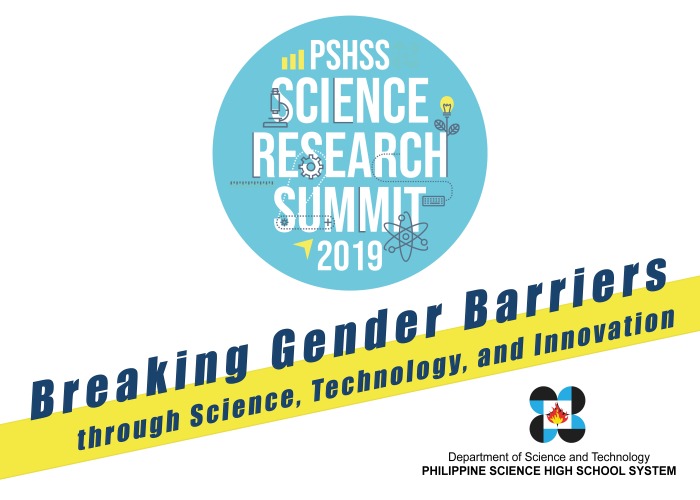
August 27, 2019 in Subic, Zambales. More than 200 Grade 12 PSHS students from 13 PSHS campuses around the country convene in Subic to present their researches to a panel of experts, and to the public in this year’s science research summit. A total of 48 research projects will be subjected for critiquing of experts during the oral presentation. These researches will also be displayed for public viewing during the community fair on August 30.
In the morning, PSHS students started setting up their research posters at the designated area in Subic Bay Travelers Hotel. To get the ball rolling, the PSHS System organizers involved the students in student leadership and team building activities with the aim to harness their leadership skills and camaraderie. Then, they were engaged in technical rehearsals for their upcoming oral presentation.
The DOST-PSHS System Science Research Summit 2019 carries the theme Breaking Gender Barriers through Science, Technology, and Innovation. It will run from August 28-30 at Subic Bay Travelers Hotel. In addition to harnessing the capacity of the PSHS students in understanding their researches, this summit targets to increase the awareness and interest of the communities in science, technology, and innovation.

- Already have a WordPress.com account? Log in now.
- Subscribe Subscribed
- Report this content
- View site in Reader
- Manage subscriptions
- Collapse this bar
SCIENCE INVESTIGATORY PROJECTS Gallery of Muntinlupa National High School :)
This is a collection of science fair research ideas and a showcase of Muntinlupa National High School students' investigatory projects, with the objective of promoting scientific research among the general public. The entire write-up for every project is NOT displayed for copyright purposes; only RANDOM parts of the project are shown instead. Further questions about the projects presented should be directed to the researchers or the project adviser. FEEL FREE TO BROWSE!
Tuesday, March 8, 2016
Anthracnose inhibiting activity of madre de cacao (gliricidia sepium) leaf extract on post – harvest tomato (solanum lycopersicum), mucus from brown garden snail (helix aspersa) as desiccating agent to absorb moisture, wound healing effect of ashitaba (angelica keiskei) extract on albino mice, utilization of aratilis (muntingiacalabura) as feedstock for bioethanol, the exterminating effect of cane toad (bufo marinus) bufotoxin crude extract against rice black bug (scotinophara coarctata), one of the reasons for rice shortage in the country is pest infestation, specifically, by rice black bug. the researchers were challenged to come up with another method of combating rice black bugs in the rice field, without altering the balance of nature. upon seeking ways to exterminate these unwanted pests, the researchers investigated the exterminating property of cane toad (bufo marinus) crude extract against rice black bug. the pesticide was derived from the extraction of the 22.5 grams of crude extract. the following experimental set-ups had been made: 30% crude extract and 70% corn oil solution (0.3 grams of crude extract and 0.7grams corn oil solution); 50% crude extract and 50% corn oil solution (0.5 grams of crude extract and 0.5 grams corn oil solution); 70% crude extract and 30% corn oil solution (0.7 grams of crude extract and 0.3 grams corn oil solution.); and 100% crude extract (1 gram of crude extract). using the different concentrations, the effectiveness was tested to the rice black bug (scotinophara coarctata) , in terms of mortality rate. t- test showed that there was no significant difference between the experimental product and the commercial bug killer in terms of the pest’s mortality rate, at 0.05 level of significance. the results of experimentation and data analysis showed that the experimental product was just as effective as the commercial bug killer in eradicating pests. thus, the organic pesticide obtained from cane toad (bufo marinus) crude extract could be an alternative to the commercial bug killer., wednesday, december 26, 2012, a tribute to mark lorenz valdez.
Friday, October 7, 2011
Multi-colored fabric dye from talisay (terminalia catappa) leaves extract.
Thursday, October 6, 2011
Akapulko (cassia alata l.) seeds as purgative extender for pulvoron, wednesday, october 5, 2011, makahiya (mimosa pudica) root extract as an alternative ovicide against dengue mosquito (aedes aegypti) eggs.

Reflections beyond implementation: Evaluation of the project-based learning in the research curriculum of the Philippine Science High School - Luzon campuses
- Leo Peter Dacumos School of Advanced Studies, Saint Louis University and Philippine Science High School - Cordillera Administrative Region Campus
- Dorothy Silva School of Teacher Education, Saint Louis University
STEM schools have put priority on establishing research education as a core program that enables students to choose a topic of their choice, identify a problem, and find a solution to it through experimentation and other modes of data collection. At the Philippine Science High Schools, one of its key goals is to foster a research culture among its scholars, who will help to strengthen the country's academic and scientific workforce and contribute to its success in the future. To improve instructional teaching, the project-based learning (PBL) approach has been utilized in many academic courses. A cache of studies has delved into the use of project-based learning approaches in many academic courses but the research education. This research project aimed to evaluate the implementation of project-based learning (PBL) in the STEM Research curriculum of the Philippine Science High School – Luzon campuses. Select teachers from the Philippine Science High School have shared their thoughts through the qualitative interview tool. The use of qualitative interview tool is aimed to explore their thoughts and opinions regarding the various aspects of project-based learning (PBL) implementation within the PSHS research curriculum. Thematic analysis using phenomenological reduction shows emerging themes highlighting the benefits, challenges, and things that are needed to start to improve the implementation of the project-based learning approach within the research curriculum of the PSHS system.
Academic Programs in PSHS (2016). Retrieved from https://cvc.pshs.edu.ph/index.php/2014-08-18-01-31-46/academic-programs
An Act to Establish the Philippine Science High School System and Providing Funds Therefor, Republic Act No. 8496 (1998).
Anh, V.T.K. (2018). Evaluation models in educational programs: Strengths and weaknesses. VNU Journal of Foreign Studies, 34(2), 140-150. https://doi.org/10.25073/2525-2445/vnufs.4252
Arnilla, A. K. (n.d.) Philippine science high school: A model for STEAM education. Retrieved from https://www.researchgate.net/profile/Arvin-Kim-Arnilla/publication/331980162_Philippine_Science_High_School_A_Model_for_STEAM_Education/links/5c9890b6a6fdccd460385914/Philippine-Science-High-School-A-Model-for-STEAM-Education.pdf
Bagheri, M ., Zah, W., Ali, W., Chong, M., Abdullah, B., & Daud, S. M. (2013). Effects of project-based learning strategy on self-directed learning skills of Educational Technology students. Cedtech.net. https://www.cedtech.net/download/effects-of-project-based-learning-strategy-on-self-directed-learning-skills-of-educational-6089.pdf
Barron, B., Schwartz, D . , Vye, N., Moore, A., Petrosino, L., & Bransford, J. (1998). Doing with understanding: lessons from research on problem and project-based learning. The Journal of the Learning Science. 7(3), 271-311. Retrieved from http://web.mit.edu/monicaru/Public/old%20stuff/For%20Dava/Grad%20Library.Data/PDF/Brigid_1998DoingwithUnderstanding-LessonsfromResearchonProblemandProject-BasedLearning-1896588801/Brigid_1998DoingwithUnderstandingLessonsfromResearchonProblemandProject-BasedLearning.pdf
Bass, G (2011). Investigating the effects of project-based learning on students' academic achievement and attitudes towards English lessons. The Online Journal of New Horizons in Education, 1(4), 1-25. Retrieved from https://www.tojsat.net/journals/tojned/volumes/tojned-volume01-i04.pdf#page=8
Bell, S. (2010). Project-Based Learning for the 21st Century: Skills for the Future. The Clearing House: A Journal of Educational Strategies, Issues and Ideas, 83(2), 39-43. https://doi.org/10.1080/00098650903505415
Bell, S., Crane, R., & Thomson, J. (2020). Project-based learning and assessment for learning: Capturing complex knowledge. Assessment in Education: Principles, Policy & Practice, 27(4), 403-419.
Bergeron, H. (2022, March 3). Using PBL to build a strong learning community. Edutopia; George Lucas Educational Foundation. https://www.edutopia.org/article/using-pbl-build-strong-learning-community/
Boaler, J. (2002). Learning from teaching: Exploring the relationship between curriculum reform and equity. Journal for Research in Mathematics Education, 33(4), 239-258. https://doi.org/10.2307/749740
Boss, S., Cannady, M., & Glazewski, K. (2021). Authentic assessment in project-based learning: Challenges and opportunities. Theory Into Practice, 60(3), 250-259.
Brandt, C. (2020). Measuring student success skills: A review of the literature on self-directed learning. Retrieved from https://files.eric.ed.gov/fulltext/ED607782.pdf
Brooks, S. F. (2016). Examining the implementation challenges of project-based learning: A case study. https://www.proquest.com/dissertations-theses/examining-implementation-challenges-project-based/docview/1799283727/se-2
Burcu, O. (2020). Refocusing group work on collaborative learning and diversifying assessments in political science departments. European Political Science, 19(1), 140–157. https://doi.org/10.1057/s41304-019-00212-6
Cho, Y. & Brown, C. (2013). Project-based learning in education: integrating business needs and student learning. European Journal of Training and Development, 37(8), 744-765. https://doi.org/10.1108/EJTD-01-2013-0006
Ciftci, S. (2015). The effects of using project-based learning in social studies education to students' attitudes towards social studies courses. Procedia - Social and Behavioral Sciences, 186, 1019-1024. https://doi.org/10.1016/j.sbspro.2015.04.205
Dacumos, L.P.N. & Kita, M. (2021). Through the teacher's lens: Evaluation of the project-based curricula of Philippine and Japanese science high schools. SEAQIS Journal of Science Education, 1(2), 1-17. https://doi.org/10.58249/sjse.v1i02.37
Daro, P., Mosher, F., & Corcoran, T. (2011). Learning trajectories in mathematics: A foundation for standards, curriculum, assessment, and instruction. CPRE Research Report #RR-68. Philadelphia: Consortium for Policy Research in Education. https://doi.org/10.12698
Davis, P. M., & Walters, W. H. (2011). The impact of free access to the scientific literature: a review of recent research. Journal of the Medical Library Association: JMLA, 99(3), 208–217. https://doi.org/10.3163/1536-5050.99.3.008
Diffily, D. (2002). Project-based learning: Meeting social studies standards and the needs of gifted learners. Gifted Child Today, 25(3). https://doi.org/10.4219/gct-2002-69 Engaging Stakeholders. (n.d.). READING FIRST sustainability series. Www2.ed.gov. Retrieved June 27, 2023, from https://www2.ed.gov/programs/readingfirst/support/stakeholderlores.pdf
Fajutagan, N.S. (2016). Against all odds: 20 years of PBL in the Philippines. Airiti Library. https://doi.org/10.6145/jme201617 .
Field, S. (2021). How to scaffold in project-based learning. PBL Works. Retrieved June 30, 2023, from https://www.pblworks.org/blog/how-scaffold-project-based-learning
Grossman, P., Dean, C. G. P., Kavanagh, S. S., & Herrmann, Z. (2019). Preparing teachers for project-based teaching. Phi Delta Kappan, 100(7), 43–48. https://doi.org/10.1177/0031721719841338 http://eprints.ncrm.ac.uk/423/1/0206_anonymity%2520and%2520confidentiality.pdf
Hugerat, M. (2016). How teaching science using project-based learning strategies affects the classroom learning environment. Learning Environments Research, 19, 383-395. https://doi.org/10.1007/s10984-016-9212-y
Hung, W. (2009). The 9-step problem design process for problem-based learning: Application of the 3C3R model. Educational Research Review, 3(2), 118-141. https://doi.org/10.1016/j.edurev.2008.12.001
Ilter, I. (2014). A study on the effectiveness of project-based learning approach on social studies education: Conceptual achievement and academic motivation. Education Research and Reviews, 9(15), 487-497. https://doi.org/10.5897/ERR2014.1777
Issa, H. B., & Khataibeh, A. (n.d.). The effect of using project-based learning on improving the critical thinking among upper basic students from teachers' perspectives. Pegem Journal of Education and Instruction, 11(2), 52-57. https://doi.org/10.14527/pegegog.2021.00
Jorn, L., and A. Duin. 1992. Information technology and the collaborative writing process in the classroom. The Bulletin of the Association for Business Communication 55(4): 13–20. https://doi.org/10.1177/108056999205500404
Karan, E., & Brown, L. (2022). Enhancing student's problem-solving skills through project-based learning. Journal of Problem Based Learning in Higher Education, 10(1), 74-87. https://doi.org/10.5278/ojs.jpblhe.v10i1.6887
Kettler, T., & Puryear, J. (2018). Curriculum, methods, and authentic experiences in science and mathematics specialized schools. Specialized Schools for High-Ability Learners: Designing and Implementing. Sourcebooks, Incorporated.
Kilbane, C. R., & Milman, N. B. (2011). Examining the impact of the creation of digital portfolios by high school teachers and their students on teaching and learning. Theijep.com. https://www.theijep.com/pdf/IJEP249.pdf
Kimbrel, L. (2016). The four stages of curriculum development. Retrieved from https://lauriekimbrel.wordpress.com/2016/07/06/the-four-stages-of-curriculum-development/
Kirschner, P. A., Sweller, J., & Clark, R. E. (2006). Why minimal guidance during instruction does not work: An analysis of the failure of constructivist, discovery, problem-based, experiential, and inquiry-based teaching. Educational Psychologist, 41(2), 75–86. https://doi.org/10.1207/s15326985ep4102_1
Krajcik, J. S., Czerniak, C. M., & Berger, C. F. (2021). Project-based teaching and learning in science education: An exemplar from the Next Generation Science Standards. Routledge.
Krajic, J.S. (2001). Supporting science learning in context: Project-based learning. Portable Technologies. Innovations in Science Education and Technology, 13. https://doi.org/10.1007/978-94-010-0638-5_2
Kubiatko, M. & Vaculova, I. (2011). Project-based learning: Characteristic and the experiences with application in the science subjects. Energy Education Science and Technology Part B: Social and Educational Studies, 3(1), 65-74. Retrieved from https://www.researchgate.net/profile/Milan-Kubiatko/publication/230806658_Project-based_learning_Characteristic_and_the_experiences_with_application_in_the_science_subjects/links/0f4637d7db183b0950b79d3d/Project-based-learning-Characteristic-and-the-experiences-with-application-in-the-science-subjects science-subjects.pdf
Kusmawan, U., O'Toole, J. M., Reynolds, R., & Bourke, S. (2009). Beliefs, attitudes, intentions and locality: the impact of different teaching approaches on the ecological affinity of Indonesian secondary school students. International Research in Geographical and Environmental Education. https://doi.org/10.1016/j.recep.2016.08.029 .
Kusmawan, Udan, and Rafidah Abd. Kareem. 2022. Teaching And Learning During Covid-19 And Beyond. In , edited by Udan Kusmawan and Rafidah Abd. Karim, 1st ed., 67. Jogjakarta: Deepublish.
Kusmawan, Udan. 2022. A Virtual Lab As A Vehicle For Active Learning Through Distance Education. International Jounrla on Research in STEM Education. 4 (2): 18–38.
Langoban, M. (2020). What makes mathematics difficult as a subject for most students in higher education? International Journal of English and Education, 9(3), 214-220. Retrieved from https://www.researchgate.net/publication/342888714_What_Makes_Mathematics_Difficult_as_a_Subject_for_most_Students_in_Higher_Education
Larmer, J., & Mergendoller, J. R. (2010). Seven essentials for project-based learning. Educational leadership, 68(1), 34-37. Retrieved from https://www.ascd.org/el/articles/seven-essentials-for-project-based-learning Larmer, J., Mergendoller, J. R., & Boss, S. (2015). Setting the standard for project-based learning: A proven approach to rigorous classroom instruction. Interdisciplinary Journal of Problem-based Learning, 11(2). http://dx.doi.org/10.7771/1541-5015.1721
Lee, D., Huh, Y., & Reigeluth, C. M. (2015). Collaboration, intragroup conflict, and social skills in project-based learning. Instructional Science, 43(5), 561–590. https://doi.org/10.1007/s11251-015-9348-7
Lee, J., Jeong, H., & Hong, S.C. (2018). Fostering project-based learning and performance assessment. Human Capital and Development, 182-221. https://doi.org/10.4337/9781786436979.00012
Lenz, B., & Larmer, J. (n.d.). Project-based learning that makes a difference. ASCD. Retrieved June 25, 2023, from https://www.ascd.org/el/articles/project-based-learning-that-makes-a-difference
Lincoln, Y.S., & Guba, E.G (1985). Naturalistic inquire. Newbury Park, CA: Sage Pub
Marfal, A. M. (2017, May 24). DOST to stage "science for the people" on S & T week. Gov.Ph. https://stii.dost.gov.ph/669-dost-to-stage-science-for-the-people-on-s-t-week
Mark, R. (2016, March 16). Real-world problems and project-based learning : Innovative Education in VT; Tarrant Institute for Innovative Education. https://tiie.w3.uvm.edu/blog/real-world-problems-and-project-based-learning/
McGrath, M. M., Fullilove, R. E., Kaufman, M. R., Wallace, R., & Fullilove, M. T. ( 2009). The limits of collaboration: A qualitative study of community ethical review of environmental health research. American Journal of Public Health, 99(8), 1510–1514. https://doi.org/10.2105/ajph.2008.149310
Melaville, A., Berg, A., & Blank, M. (2006). Community-based learning: Engaging students for success and community-based learning: Engaging students for success and Citizenship. Unomaha.edu. Retrieved June 27, 2023, from https://sl.ut.ac.id/1ph0
Molina-Torres, M.-P. (2022). Project-based learning for teacher training in primary education. Education Sciences, 12(10), 647. https://doi.org/10.3390/educsci12100647
O'Brien, M. (n.d.). What is Project Based Learning? Definedlearning.com. Retrieved June 25, 2023, from https://blog.definedlearning.com/blog/what-is-project-based-learning
Pareek, R. B. (2019). An assessment of availability and utilization of laboratory facilities for teaching science at secondary level. Science Education International, 30(1), 75–81. https://doi.org/10.33828/sei.v30.i1.9
Parwati, N. W., Suarni, N. K., Suastra, I. W., & Adnyana, P. B. (2019). The effect of project based learning and authentic assessment on students' natural science learning outcome by controlling critical thinking skill. Journal of Physics. Conference Series, 1318(1), 012096. https://doi.org/10.1088/1742-6596/1318/1/012096
PBL Works (n.d.) “doing a project” VS. project-based learning. Retrieved from https://www.pblworks.org/doing-project-vs-project-based-learning
Philippine Science High School (2016). Curriculum review and feedback. Curriculum and Instruction Manual (CIM 4.1). Retrieved from https://cvisc.pshs.edu.ph/transparency/2017/QMS/curriculum_and_instruction_manual/CIM_4-1_Curriculum_Review_and_Feedback.pdf Philippine Science High School (n.d.). Research overview. Retrieved from https://cvc.pshs.edu.ph/index.php/2014-08-27-06-42-10/overview
Poonpon, K. (2017). Enhancing english skills through project-based learning. The English Teacher, 40, 1-10. Retrieved from https://melta.org.my/journals/TET/downloads/tet40_01_01.pdf
Porath, M. &Jordan, E. (2023). Problem-based Learning Communities: Using the Social Environment to Support Creativity. Encyclopedia.com. Retrieved June 24, 2023, from https://www.encyclopedia.com/education/applied-and-social-sciences-magazines/problem-based-learning-communities-using-social-environment-support-creativity
Poth, R. D. (2016). Project-based learning: What it is and how it benefits students. Easybib.com. Retrieved June 25, 2023, from https://www.easybib.com/guides/project-based-learning-benefits-students/
Project based learning training course for teachers. (n.d.). Teacher Training. Retrieved June 29, 2023, from https://www.erasmustrainingcourses.com/project-based-learning.html
PSHS System -Philippine science high school system (2019). F.O.R.W.A.R.D. framework. https://pshs.edu.ph/the-pshs-system/
Rafanan, R. J., de Guzman, C. Y., & Rogayan, D., Jr. (2020). Pursuing STEM careers: Perspectives of senior high school students. Participatory Educational Research, 7(3), 38–58. https://doi.org/10.17275/per.20.34.7.3
Research and Practice, 22(1), 47-57. https://doi.org/10.1111/j.1540-5826.2007.00230.x
Saldana, Johnny (2009). The Coding Manual for Qualitative Researchers. Thousand Oaks, California: Sage.Sam, A. (2021). What is curriculum evaluation: Importance and roles. Retrieved from https://notesread.com/curriculum-evaluation/
Savery, J. R. (2006). Overview of problem-based learning: Definitions and distinctions. Interdisciplinary Journal of Problem-Based Learning, 1(1), 9-20. https://doi.org/10.7771/1541-5015.1002
Sergio, M. (2011). K-12 education reform: Problems and prospects. Edu.Ph. Retrieved June 30, 2023, from https://www.adnu.edu.ph/urc/download/p070p080.pdf
Solomon, G. (2003). Project-based learning: A primer. Technology & Learning, 23, 20-27. Retrieved from https://wethinkdigital.fb.com/learning/ph/wp-content/uploads/sites/38/2021/10/Primer-on-PBLpdf.pdf
Spinella, M. (2008). JSTOR and the changing digital landscape. Interlending & Document Supply, 36(2), 79–85. https://doi.org/10.1108/02641610810878549
Swars, S., Hart, L. C., Smith, S. Z., Smith, M. E., & Tolar, T. (2007). A longitudinal study of elementary pre-service teachers’ mathematics beliefs and content knowledge. School Science and Mathematics, 107(9), 325-335. https://doi.org/10.1111/j.1949-8594.2007.tb17797.x
TeachThought Staff (2019). The difference between projects and PBL. Retrieved from https://www.teachthought.com/project-based-learning/difference-between-doing-projects-and-pbl/
Tenopir, C., Dalton, E. D., Allard, S., Frame, M., Pjesivac , I., Birch, B., Pollock, D., & Dorsett, K. (2015). Changes in data sharing and data reuse practices and perceptions among scientists worldwide. PLOS ONE, 10(8), e0134826. https://doi.org/10.1371/journal.pone.0134826
Thomas, J. W., Mergendoller, J. R., & Michaelson, A. (2018). Project-based learning: A handbook for middle and high school teachers. ASCD.
Thomas, J., & Williams, C. (2010). The history of specialized STEM schools and the formation and role of the NCSSSMST. Roeper Review, 32, 17-24. https://doi.org/10.1080/02783190903386561
Thomas, J.W. (2000). A review of research on project-based learning. My PBL Works. Retrieved from http://www.bobpearlman.org/BestPractices/PBL_Research.pdf
Tze Kiong, T., Mohd. Rusly, N. S., Abd Hamid, R. I., Charanjit Kaur Swaran, S., & Hanapi, Z. (2022). Inventive problem-solving in project-based learning on design and technology: A needs analysis for module development. Asian Journal of University Education, 18(1), 271. https://doi.org/10.24191/ajue.v18i1.17196
Winnen, A. (2016). The importance of school vision in personalized learning and project-based learning. KnowledgeWorks. https://knowledgeworks.org/resources/vision-personalized-learning/
Wolk, S. (1994). Project-based learning: pursuits with a purpose. Educational Leadership, 52(3), 42-45. Retrieved from http://web.a.ebscohost.com/ehost/pdfviewer/pdfviewer?vid=2&sid=95a3a9f9-7a78-4ff7-a420-836d55d1c4e9%40sessionmgr4002&hid=4214 .
Yan, X.-Q., Zhou, Y.-Y., Zhang, K., & Cui, G.-Y. (2023). Perceived teacher enthusiasm and professional commitment: The mediating role of boredom and learning engagement. Psychology Research and Behavior Management, 16, 1149–1163. https://doi.org/10.2147/PRBM.S400137
How to Cite
- Endnote/Zotero/Mendeley (RIS)
Copyright (c) 2023 Leo Peter Dacumos, Dorothy Silva

This work is licensed under a Creative Commons Attribution-NonCommercial 4.0 International License .
Content Licensing, Copyright, and Permissions
5. Co-Authorship If the article was jointly prepared by other authors, the signatory of this form warrants that he/she has been authorized by all co-authors to sign this agreement on their behalf and agrees to inform his/her co-authors of the terms of this agreement. 6. Termination This agreement can be terminated by the author or International Journal of Research in STEM Education at two months’ notice where the other party has materially breached this agreement and failed to remedy such breach within a month of being given the terminating party’s notice requesting such breach to be remedied. No breach or violation of this agreement will cause this agreement or any license granted in it to terminate automatically or affect the definition of the International Journal of Research in STEM Education. 7. Royalties This agreement entitles the author to no royalties or other fees. To such extent as legally permissible, the author waives his or her right to collect royalties relative to the article in respect of any use of the article by This agreement can be terminated by the author or International Journal of Research in STEM Education upon two months’ notice where the other party has materially breached this agreement and failed to remedy such breach within a month of being given the terminating party’s notice requesting such breach to be remedied. No breach or violation of this agreement will cause this agreement or any license granted in it to terminate automatically or affect the definition of the International Journal of Research in STEM Education or its sublicensee. 8. Miscellaneous International Journal of Research in STEM Education will publish the article (or have it published) in the journal if the article’s editorial process is successfully completed and the International Journal of Research in STEM Education or its sublicensee has become obligated to have the article published. International Journal of Research in STEM Education may conform the article to a style of punctuation, spelling, capitalization, referencing, and usage that it deems appropriate. The author acknowledges that the article may be published so that it will be publicly accessible, and such access will be free of charge for the readers.
SUBMISSION
Author Guidelines
Article Processing Charge
Copyright Notice
Privacy Statement
ARTICLE TEMPLATE

PEOPLE
Editorial Board
Scientific Reviewer
POLICIES
Focus and Scope
Journal History
Indexing and Abstracting
Peer Review Process
Open Access Policy
Advertising Policy
Archiving Policy
Publication Ethics Statement
Allegations of Misconduct
Screening for Plagiarism
Correction and Retraction
Crossmark Policy
AFFILIATIONS

TOOLS

STATISTICS
Published by:
THE INSTITUTE OF RESEARCH AND COMMUNITY SERVICES (LPPM), UNIVERSITAS TERBUKA, INDONESIA
The International Journal of Research in STEM Education (IJRSE)
Mailing Address: Faculty of Teacher Training and Education Universitas Terbuka Indonesia Jl. Pd. Cabe Raya, Pd. Cabe Udik, Kec. Pamulang, Kota Tangerang Selatan, Banten 15418. Phone: (021) 7490941.
Email: [email protected] ; [email protected]


- You are here:
- Quick Information Dispatch (QID) Articles
DOST-PCAARRD helps future-proof the Philippine Science High School System through capacity-building on intellectual property and technology transfer

The Department of Science and Technology’s Philippine Science High School System (DOST-PSHSS) is currently collaborating with the Philippine Council for Agriculture, Aquatic and Natural Resources Research and Development (DOST-PCAARRD) to develop staff’s technology transfer capacity. This is being done through the project, “Developing Technology Transfer Capacity of the Philippine Science High School System (PSHSS).”
DOST-PSHSS is the premier science high school in the Philippines where students are prepared for a career in science, technology, and mathematics (STEM).
The two-year project, under the leadership of Ms. Jodi Mylene Lopez, aims to enhance the intellectual property (IP) and technology transfer system among the 16 PSHS campuses and enhance its technology commercialization programs.
DOST-PSHSS Executive Director Lilia T. Habacon said that the project was proposed to DOST-PCAARRD as it was inspired by the System’s vision to future-proof amidst the changing demands of the industry. At PSHSS, students are trained to develop a high aptitude in science and mathematics and apply these skills in conducting research with results expected to benefit the general society. To better manage these research outputs, the project will conduct capacity-building activities and create a framework that will guide every campus to commercialize technologies developed by the students.
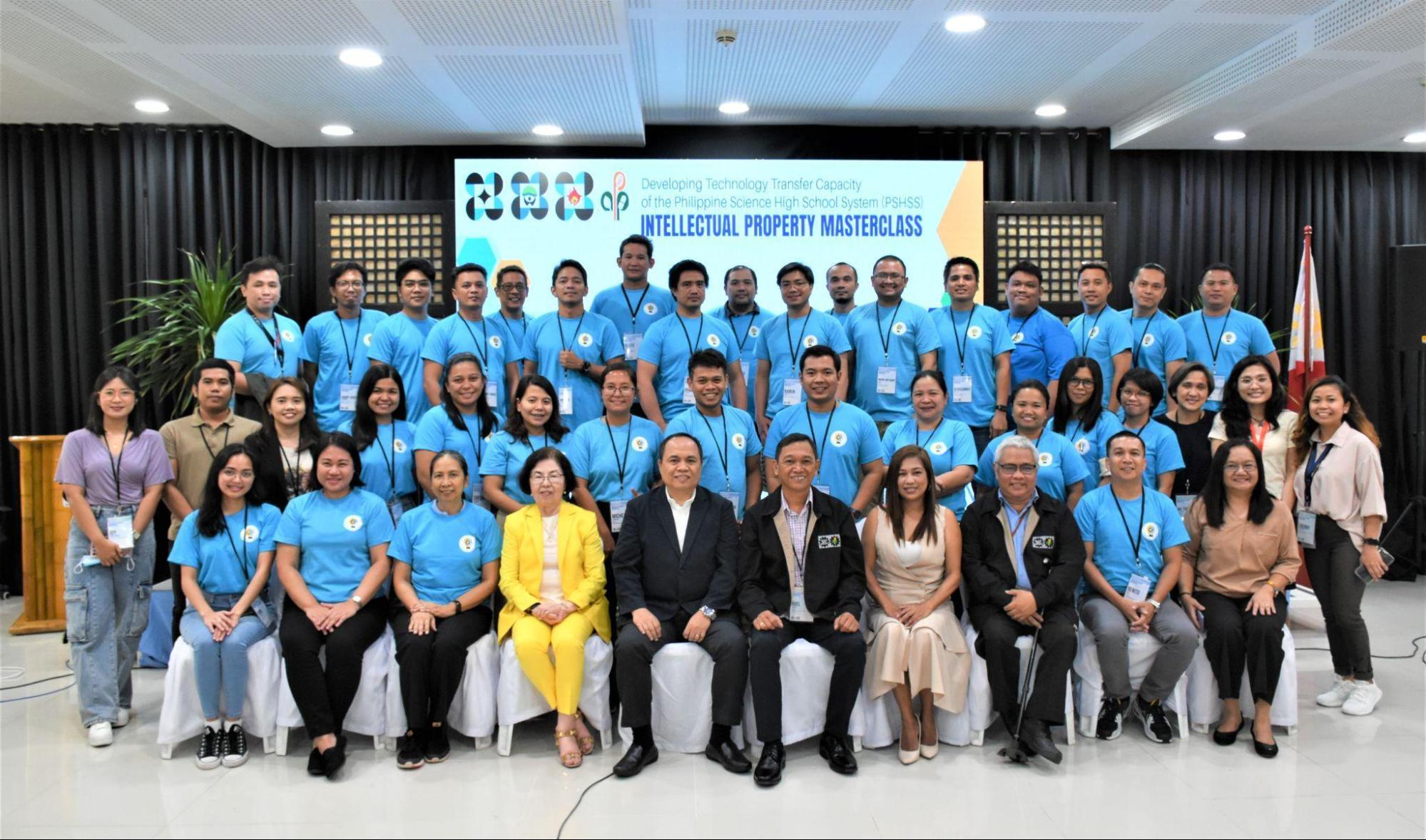
The PSHS training participants with APP Vice President Atty. Misael F. Costes, Vice President Atty. Editha R. Hechanova, and DOST-PCAARRD TTPD’s Dir. Noel A. Catibog and staff during the Intellectual Property Master Class (IPMC) which kicked off on June 14, 2023.
With this, a more holistic PSHSS that will empower the youth and science community to develop and commercialize world-class technologies, is expected.
A project inception meeting was held on June 13, 2023 at the R.D. Guerrero III Room, DOST-PCAARRD Innovation and Technology Center (DPITC), Los Baños, Laguna to discuss the implementation plans and ensure the accomplishment of the project’s goals and objectives. The meeting was attended by DOST Undersecretary for Scientific and Technical Services Maridon O. Sahagun, DOST-PCAARRD Executive Director Reynaldo V. Ebora, DOST-PSHSS Executive Director Lilia T. Habacon, DOST-PCAARRD Officer-in-Charge for Research and Development (R&D) Juanito T. Batalon, and Technology Transfer and Promotion Division (TTPD) Director Noel A. Catibog. Likewise, as the project's training services provider and partner, Association of PAQE Professionals (APP) President Misael F. Costes and Vice President Editha R. Hechanova also participated in the meeting.
Being the first training under the project, the DOST-PCAARRD Intellectual Property Master Class (IPMC) kicked off with the first module focused on the introduction to IP management, prior art search report, and invention spotting.
The five-module, 15-day DOST-PCAARRD IPMC was conducted from June to July 2023 via hybrid learning mode. Trainees used the research outputs of students from their respective campuses as training material during prior art search and claim drafting up to actual IP application. Moreover, the IPMC graduation ceremony was conducted on July 28, 2023 to mark its completion and to recognize the dedication and hard work of the trainees and the training provider APP. The ceremony conferred 32 IPMC graduates and awarded the topnotchers of the mock exams with cash prizes worth P2,000 (Top 3), P3,000 (Top 2) and P5,000 (Top 1), by APP.
Topnotchers of the Chemical Patenting Mock Exam:
|
|
|
| Top 3 | Pelayre, Ann Fatima T. | Zamboanga Peninsula Region Campus |
| Top 2 | Bagasbas, Jefrey M. | SOCCSKSARGEN Region Campus |
| Top 1 | Estoque, Jesse Ronald M. | Eastern Visayas Campus |
Topnotchers of the Non-Chemical/Mechanical patenting Mock Exam:
|
|
|
| Top 3 | Lonzaga, Ace L. | Southern Mindanao Campus |
| Top 2 | Casimiro, Jerile Mae E. | Ilocos Region Campus |
| Top 1 | Amorin, Marc Earl C. | Ilocos Region Campus |
This batch of IP Master Class graduates filed and drafted a total of 30 IP applications including 20 patents and 10 utility models. However, more than these numbers, Dr. Ebora emphasized that this comprehensive mentorship program equipped these aspiring patent agents with five P-I-S-A-Y important traits: 1.) Proficient communicators who are proficient in using words with a versatile communication style as translators of technology, business, and law; 2.) Investigative thinkers who find the best way to protect the technology; 3.) Steadfast or simply diligent; 4.) Analytical thinkers who are critical of data and evidence and comprehensive in processing legal, commercial, and scientific information; and 5.) With an ‘eYe’ for detail in preparing IP applications.
Dr. Ebora congratulated the graduates especially for being P roficient communicators, I nvestigative-thinkers, S teadfast, and A nalytical thinkers with an e Y e for detail or simply P-I-S-A-Y technology transfers agents.
The IPMC will be followed by the DOST-PCAARRD Technology Commercialization Mentorship Series (TCMS), which will focus on the strategies to promote and commercialize technologies generated by PSHSS. It will run from October to December 2023.
- Follow us on Facebook
- Watch, subscribe,like
- Follow us on Twitter
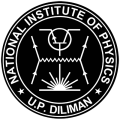
National Institute of Physics
College of Science, University of the Philippines, Diliman, Quezon City
High School Investigatory Projects
The National Institute of Physics (NIP) welcomes the opportunity to guide High School students in their Investigative Projects (IPs). The objective is to introduce young students to a refined view of science and provide them with meaningful experience.
For this program, Doing Science for Science Sake , is an all encompassing theme. We encourage original proposals.
Send your project proposals for evaluation and get a chance to work with NIP and its facilities. It is always an advantage to identify an NIP Professor who might be able to guide the students in the conduct of the project. Those interested in pursuing investigations with NIP are encouraged to go through the guidelines below.
- Subject of the investigation and relevance
- Reasons and Motivations for undertaking the investigations
- Methods to be used and the reason for its use.
- Duration and anticipated expenditures
- Why the activity is required by the school and to what end the project may be carried to
- The extent of logistic and financial support your school is willing to extend to your project
- The extent of academic support and guidance you will receive from your school advisers
- Its willingness to acknowledge the contribution of the NIP and willingness to share with NIP all honors, citations, etc., that may be accorded to the project.
- Together with the students, the high school student adviser must present the project proposal to the NIP.
- The adviser must accompany the students, at all times, during the course of their work at NIP.
- In case your IP proposal is approved, your Parents/Guardians and school must issue a statement that the National Institute of Physics and the University of the Philippines shall not be liable for any accidents or body injuries, including death, occurring to you and for any loss of your personal property while in the premises of the University.
- You may not be allowed to include the IP as an entry to a science contest!
You will be notified of the extent of NIP support for your project upon approval. This approval may include certain conditions that you may have to agree to or bind yourself with before you can proceed. Clearly indicate the contact details for notification of the approval.
Academia.edu no longer supports Internet Explorer.
To browse Academia.edu and the wider internet faster and more securely, please take a few seconds to upgrade your browser .
Enter the email address you signed up with and we'll email you a reset link.
- We're Hiring!
- Help Center

UTILIZATION OF PROJECT-BASED LEARNING (PBL) RESOURCES IN SENIOR HIGH SCHOOL

2021, IOER International Multidisciplinary Research Journal
This study assessed the utilization of project-based learning (PBL) resources in Senior High schools. It described the PBL resources and the extent of their utilization along science, technology, engineering, and mathematics (STEM) components. It compared the administrators' and teachers' assessment on the PBL resources. Further, it identified the opportunities and challenges in these resources. A management program was prepared to enhance the delivery of STEM instruction. This study used the descriptive method of research with a questionnaire as the main data gathering instrument. Unstructured interview and focus group discussion complemented the results. Respondents were 124 administrators and 304 STEM teachers from the four Division of Batangas-Division of Lipa, Batangas, Batangas City, and Tanauan. Weighted mean and t-test were used in the analysis of data. Project-based learning in public senior high schools was supported with capable teachers and sufficient material resources. The utilization of PBL resources Along Science, Technology, Engineering, and Mathematics was observable among STEM teachers, yet there was seeming need to use them more extensively for better Science instruction.
Related Papers
International Journal on Research in STEM Education
Leo Peter Dacumos
STEM schools have put priority on establishing research education as a core program that enables students to choose a topic of their choice, identify a problem, and find a solution to it through experimentation and other modes of data collection. At the Philippine Science High Schools, one of its key goals is to foster a research culture among its scholars, who will help to strengthen the country's academic and scientific workforce and contribute to its success in the future. To improve instructional teaching, the project-based learning (PBL) approach has been utilized in many academic courses. A cache of studies has delved into the use of project-based learning approaches in many academic courses but the research education. This research project aimed to evaluate the implementation of project-based learning (PBL) in the STEM Research curriculum of the Philippine Science High School – Luzon campuses. Select teachers from the Philippine Science High School have shared their thoug...
STEM Education Review
National economic development is shifting from industrial sectors such as mining, and agriculture, amongst others, to prioritizing Science, Technology, Engineering, and Mathematics (STEM) en route to building new jobs, creating growth, and driving innovation. Different nations have made significant moves to invest in STEM education primarily driven by the need to foster human resources, henceforth creating specialized schools focused on STEM fields. These schools need to couple academic learning with its application to real-world contexts and problems through project-based learning (PBL). However, while implementation and evaluation have been the subject of many studies, there is still a dearth of studies that involve evaluating the implementation of PBL as a pedagogical approach in teaching research curricula in STEM schools.
Fajar Caturangga
Integrated Science Learning is a learning that combines Physics, Chemistry and Biology into a thematic learning. In this study the Integrated Science Learning conducted through Project Based Learning that emphasizes the analysis of the factual issues and investigating the problem solving by engaging 21st Century skills. Project Based Learning is centered on the learner and affords learners the opportunity for in-depth investigations of worthy topics. The steps of PBL are: Driving question, designs a plan for the project, arrange a schedule, monitor/evaluate the progress of the project and assess the outcome. 21 st Century skills to be taught and assessed are: critical thinking/problem solving, communication/oral presentation, collaboration, and tech literacy. Subjects in this study were students of grade X (chemistry subject), grade XI Science (Physics subject) and grade XII Science (Biology subject) at Sekolah Indonesia Singapura. In this study, aspects of assessment consist of a written test, oral/presentation test and observation. Based on the results of formative tests and summative tests, this study can enhance students' understanding of science and based on the observation during the study, it was concluded that 21st Century skills appears and possessed by the student when the learning processes.
Learning and Individual Differences
Robert Capraro
Psychology and Education: A Multidisciplinary Journal
Psychology and Education , Renee Rose Corbano-Reyes
This study aimed to determine the effects of integrating Project-based learning (PBL) on the Science Process Skills and 21st-Century Skills of Grade 11 students at Rizal High School in Pasig City during school year 2022-2023.The researcher used an explanatory sequential design with three phases and a triangulation approach in data analysis. There were 23 Grade 11 ABM student participants and 30 Science teachers who were chosen as respondents for this study. The researcher recorded the students' scores in the pretest and posttest for the comparison of data, the Science teachers' rating on the PBL lesson plan, and the ethnographic evaluation. The researcher also interviewed the Science teachers on their comments and feedback on the implementation of PBL in Science class.Based on the results, both the Science experts and teacher respondents perceived the extent of integration of the Project-Based Learning as Highly Integrated (HI) in Earth Science based on the Gold Standard PBL Framework. In addition, there was no significant difference between the perception of the two groups of respondents. Meanwhile, there was a significant difference between the pretest and posttest scores of Grade 11 student respondents before and after exposure. The teacher respondents remarked that they want to receive training on Project-Based Learning approach since it is interesting and can be implemented in other subjects. The respondents also mentioned that the strategy allowed the students to have more time in meeting their groups to plan, discuss, and create their projects.
TUSED TÜFED
The integration of project-based learning in Science, Technology, Engineering, and Mathematics activities has received much attention because of its potential in engaging students with real–world problem solving. This study was designed to examine the effectiveness of Science, Technology, Engineering, and Mathematics project-based learning lessons on students’ achievement in algebra, geometry, probability and problem solving. The achievements of two groups of students who participated in the study were compared longitudinally in 2008, 2009, and 2010. The results showed that lessons integrating Science, Technology, Engineering, and Mathematics project-based learning improved students’ scores in mathematics in general (d= 1.311), algebra (d=1.500), geometry (d=1.837), and probability (d=.487), but not in problem solving (d=.343). In addition, students in Science, Technology, Engineering, and Mathematics project-based learning schools showed higher scores in geometry, probability, and problem solving than those in non Science, Technology, Engineering, and Mathematics project-based learning schools. Implications for reforming instructional approaches and suggestions for further study were discussed.
Jaka Afriana
This study was done to depict Project Based Learning (PjBL) integrated with science, technology, engineering, and mathematics (STEM), to enhance elementary school students’ science literation. Theme used in this study was air pollution. Research method was quasi experimental with The Matching-Only Pretest-Posttest Control Group Design. It was conducted in 56 seventh graders of SMP Islam Terpadu, Sukabumi in which 28 students were in experiment class, and 28 students were in control class. Data is collected by pretest and posttest of sciences literacy and students questionaire about PjBL STEM. Based on the data analysis, it was known that the N-Gain averages of sciences literacy were 0,31 in experiment class as middle category and 0,22 in control class as low category. T-test showed that scientific literacy enhancemen in experimental class was more significant than in control class. General students’ reponses showed that almost all students was excited to PjBL STEM learning, got impressive experiences during the learning and boost their learning motivation and interest
nyet moi siew
pixel-online.net
Jonah Saidson
Journal of Education For Sustainable Innovation
Abdur Rasyid
Problem-solving ability is a fundamental competence that must be mastered by students. Consequently, the educational orientation across various stages of learning should emphasize the development of this competence. The objective of this study is to enhance problem-solving skills among sixth-grade students at SDN Munjul 03 through the implementation of Project-Based Learning model with a STEM (Science, Technology, Engineering, and Mathematics) approach. The research approach employed is quantitative, employing a pre-experimental design with a one-group pretest-posttest design. The research sample comprises 41 sixth-grade students at SDN Munjul 03. Data for this study were collected through observation, interviews, and tests. The findings of the research reveal that the average scores in the problem-solving skills test after the implementation of the Project-Based Learning model with the STEM approach are significantly better than before. Descriptive analysis of these results indicat...
Loading Preview
Sorry, preview is currently unavailable. You can download the paper by clicking the button above.
RELATED PAPERS
Design and Technology Education an International Journal
Torben Steeg
RELATED TOPICS
- We're Hiring!
- Help Center
- Find new research papers in:
- Health Sciences
- Earth Sciences
- Cognitive Science
- Mathematics
- Computer Science
- Academia ©2024
- Publisher Home

- Author Guidelines
- Editorial Team
- Quality Policy
- Submission Procedure
- Publication Ethics
- Announcements
Science Investigatory Project Instruction: The Secondary Schools Journey
Main article content.
investigatory projects, science teaching, secondary schools
Science investigatory projects (SIPs) are authentic tasks that science teachers implement in science curriculum. With this, the study investigated the journey of the secondary schools in SIP instruction through the lens of the teachers. Narrative inquiry from 12 purposively selected and interviewed science teachers/winning coaches from six schools in an SIP consistent winning Division in Central Visayas, Philippines revealed that the SIP instruction journey is affected by the teachers’ prior background and implementation. They are seen to be instrumental in the SIP process, as they instill basic research skills to high school investigators, and develop the science character which is needed for them to engage in innovations in science and technology (S&T). As the teachers implement SIP instruction, they commit themselves to the development of S&T, thus placing a crucial role in the scientific community where they also develop the science research culture in the basic education level. Science teachers then should guide the students in the planning, conduct and assessment phases of SIP instruction.
Article Sidebar

Article Details

This work is licensed under a Creative Commons Attribution-NonCommercial-NoDerivatives 4.0 International License .
Modal Header
- Grades 6-12
- School Leaders
NEW: Classroom Clean-Up/Set-Up Email Course! 🧽
70 Best High School Science Fair Projects in Every Subject
Fire up the Bunsen burners!
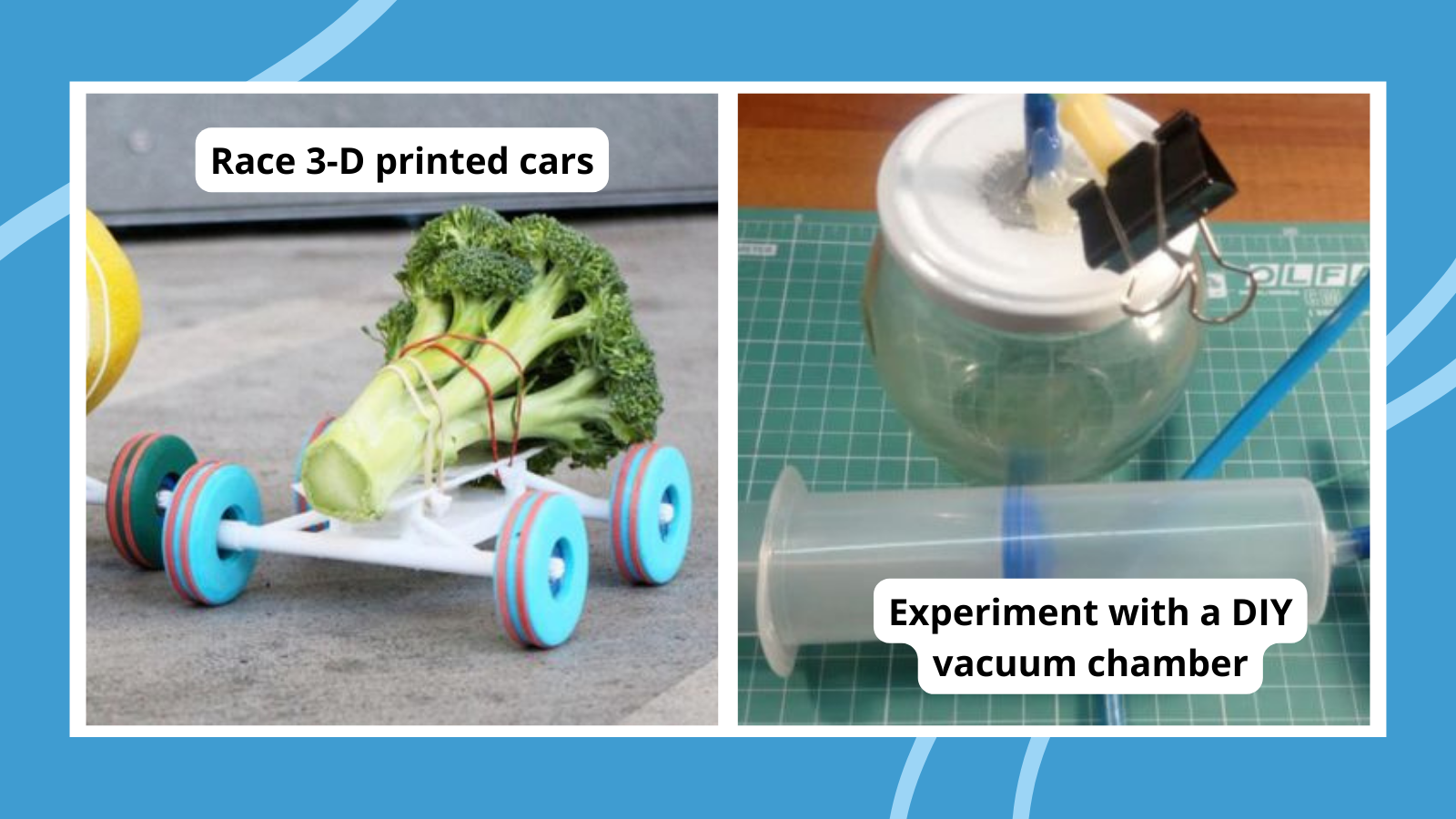
The cool thing about high school science fair projects is that kids are old enough to tackle some pretty amazing concepts. Some science experiments for high school are just advanced versions of simpler projects they did when they were younger, with detailed calculations or fewer instructions. Other projects involve fire, chemicals, or other materials they couldn’t use before.
Note: Some of these projects were written as classroom labs but can be adapted to become science fair projects too. Just consider variables that you can change up, like materials or other parameters. That changes a classroom activity into a true scientific method experiment!
To make it easier to find the right high school science fair project idea for you, we’ve rated all the projects by difficulty and the materials needed:
Difficulty:
- Easy: Low or no-prep experiments you can do pretty much anytime
- Medium: These take a little more setup or a longer time to complete
- Advanced: Experiments like these take a fairly big commitment of time or effort
- Basic: Simple items you probably already have around the house
- Medium: Items that you might not already have but are easy to get your hands on
- Advanced: These require specialized or more expensive supplies to complete
- Biology and Life Sciences High School Science Fair Projects
Chemistry High School Science Fair Projects
Physics high school science fair projects, engineering high school stem fair projects, biology and life science high school science fair projects.
Explore the living world with these biology science project ideas, learning more about plants, animals, the environment, and much more.
Extract DNA from an onion
Difficulty: Medium / Materials: Medium
You don’t need a lot of supplies to perform this experiment, but it’s impressive nonetheless. Turn this into a science fair project by trying it with other fruits and vegetables too.
Re-create Mendel’s pea plant experiment
Gregor Mendel’s pea plant experiments were some of the first to explore inherited traits and genetics. Try your own cross-pollination experiments with fast-growing plants like peas or beans.
Make plants move with light
By this age, kids know that many plants move toward sunlight, a process known as phototropism. So high school science fair projects on this topic need to introduce variables into the process, like covering seedling parts with different materials to see the effects.
Test the 5-second rule
We’d all like to know the answer to this one: Is it really safe to eat food you’ve dropped on the floor? Design and conduct an experiment to find out (although we think we might already know the answer).
Find out if color affects taste
Just how interlinked are all our senses? Does the sight of food affect how it tastes? Find out with a fun food science fair project like this one!
See the effects of antibiotics on bacteria
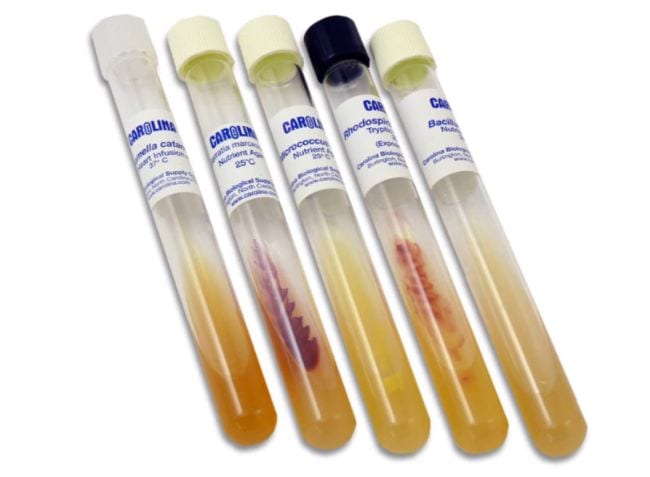
Difficulty: Medium / Materials: Advanced
Bacteria can be divided into two groups: gram-positive and gram-negative. In this experiment, students first determine the two groups, then try the effects of various antibiotics on them. You can get a gram stain kit , bacillus cereus and rhodospirillum rubrum cultures, and antibiotic discs from Home Science Tools.
Learn more: Antibiotics Project at Home Science Tools
Witness the carbon cycle in action

Experiment with the effects of light on the carbon cycle. Make this science fair project even more interesting by adding some small aquatic animals like snails or fish into the mix.
Learn more: Carbon Cycle at Science Lessons That Rock
Look for cell mitosis in an onion
Cell mitosis (division) is actually easy to see in action when you look at onion root tips under a microscope. Students will be amazed to see science theory become science reality right before their eyes. Adapt this lab into a high school science fair project by applying the process to other organisms too.
Test the effects of disinfectants

Grow bacteria in a petri dish along with paper disks soaked in various antiseptics and disinfectants. You’ll be able to see which ones effectively inhibit bacteria growth.
Learn more: Effectiveness of Antiseptics and Disinfectants at Amy Brown Science

Pit hydroponics against soil
Growing vegetables without soil (hydroponics) is a popular trend, allowing people to garden just about anywhere.
More Life Sciences and Biology Science Fair Projects for High School
Use these questions and ideas to design your own experiment:
- Explore ways to prevent soil erosion.
- What are the most accurate methods of predicting various weather patterns?
- Try out various fertilization methods to find the best and safest way to increase crop yield.
- What’s the best way to prevent mold growth on food for long-term storage?
- Does exposure to smoke or other air pollutants affect plant growth?
- Compare the chemical and/or bacterial content of various water sources (bottled, tap, spring, well water, etc.).
- Explore ways to clean up after an oil spill on land or water.
- Conduct a wildlife field survey in a given area and compare it to results from previous surveys.
- Find a new use for plastic bottles or bags to keep them out of landfills.
- Devise a way to desalinate seawater and make it safe to drink.
Bunsen burners, beakers and test tubes, and the possibility of (controlled) explosions? No wonder chemistry is such a popular topic for high school science fair projects!
Break apart covalent bonds
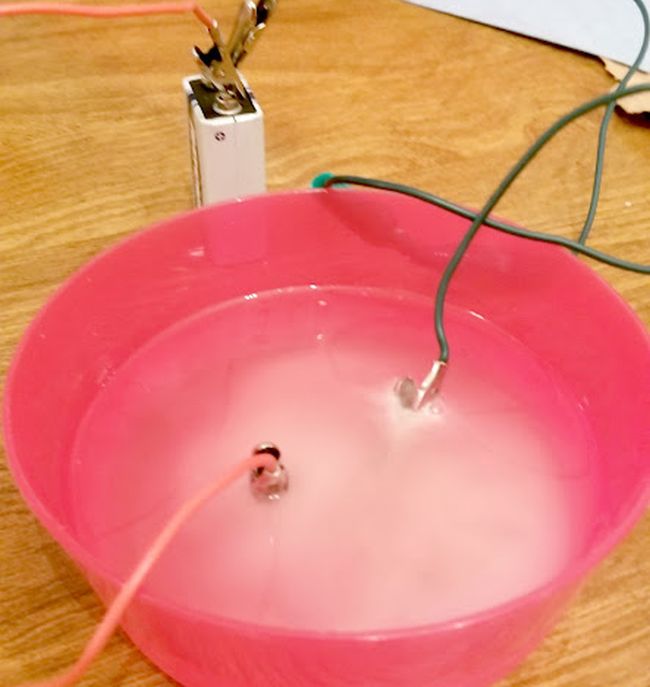
Break the covalent bond of H 2 O into H and O with this simple experiment. You only need simple supplies for this one. Turn it into a science fair project by changing up the variables—does the temperature of the water matter? What happens if you try this with other liquids?
Learn more: Covalent Bonds at Teaching Without Chairs
Measure the calories in various foods
Are the calorie counts on your favorite snacks accurate? Build your own calorimeter and find out! This kit from Home Science Tools has all the supplies you’ll need.
Detect latent fingerprints
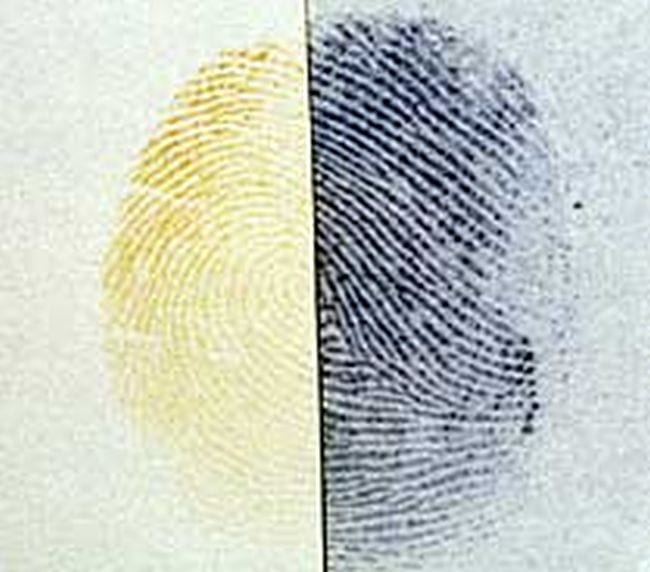
Forensic science is engrossing and can lead to important career opportunities too. Explore the chemistry needed to detect latent (invisible) fingerprints, just like they do for crime scenes!
Learn more: Fingerprints Project at Hub Pages
Use Alka-Seltzer to explore reaction rate
Difficulty: Easy / Materials: Easy
Tweak this basic concept to create a variety of high school chemistry science fair projects. Change the temperature, surface area, pressure, and more to see how reaction rates change.
Determine whether sports drinks provide more electrolytes than OJ
Are those pricey sports drinks really worth it? Try this experiment to find out. You’ll need some special equipment for this one; buy a complete kit at Home Science Tools .
Turn flames into a rainbow
You’ll need to get your hands on a few different chemicals for this experiment, but the wow factor will make it worth the effort! Make it a science project by seeing if different materials, air temperature, or other factors change the results.
Discover the size of a mole
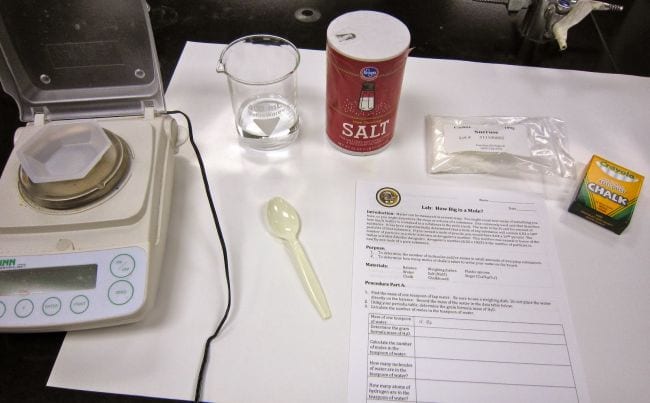
The mole is a key concept in chemistry, so it’s important to ensure students really understand it. This experiment uses simple materials like salt and chalk to make an abstract concept more concrete. Make it a project by applying the same procedure to a variety of substances, or determining whether outside variables have an effect on the results.
Learn more: How Big Is a Mole? at Amy Brown Science
Cook up candy to learn mole and molecule calculations
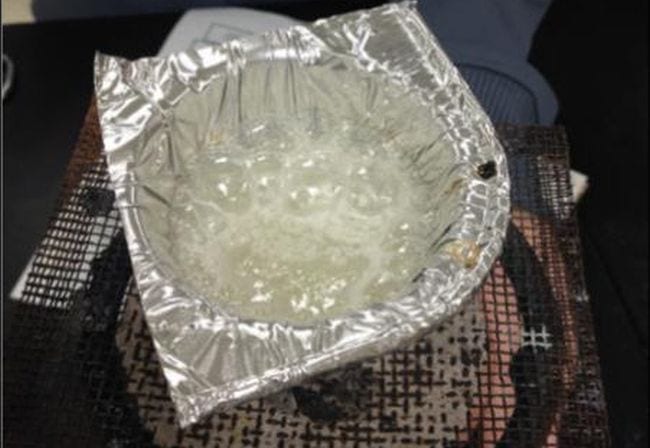
This edible experiment lets students make their own peppermint hard candy while they calculate mass, moles, molecules, and formula weights. Tweak the formulas to create different types of candy and make this into a sweet science fair project!
Learn more: Candy Chemistry at Dunigan Science on TpT
Make soap to understand saponification

Take a closer look at an everyday item: soap! Use oils and other ingredients to make your own soap, learning about esters and saponification. Tinker with the formula to find one that fits a particular set of parameters.
Learn more: Saponification at Chemistry Solutions on TpT
Uncover the secrets of evaporation
Explore the factors that affect evaporation, then come up with ways to slow them down or speed them up for a simple science fair project.
Learn more: Evaporation at Science Projects
More Chemistry Science Fair Projects for High School
These questions and ideas can spark ideas for a unique experiment:
- Compare the properties of sugar and artificial sweeteners.
- Explore the impact of temperature, concentration, and seeding on crystal growth.
- Test various antacids on the market to find the most effective product.
- What is the optimum temperature for yeast production when baking bread from scratch?
- Compare the vitamin C content of various fruits and vegetables.
- How does temperature affect enzyme-catalyzed reactions?
- Investigate the effects of pH on an acid-base chemical reaction.
- Devise a new natural way to test pH levels (such as cabbage leaves).
- What’s the best way to slow down metal oxidation (the form of rust)?
- How do changes in ingredients and method affect the results of a baking recipe?
When you think of physics science projects for high school, the first thing that comes to mind is probably the classic build-a-bridge. But there are plenty of other ways for teens to get hands-on with physics concepts. Here are some to try.
Remove the air in a DIY vacuum chamber
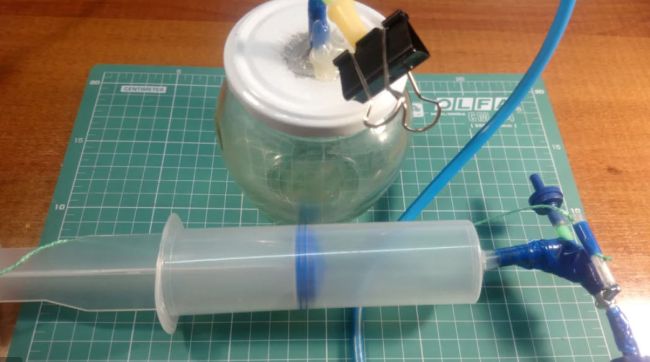
You can use a vacuum chamber to do lots of cool high school science fair projects, but a ready-made one can be expensive. Try this project to make your own with basic supplies.
Learn more: Vacuum Chamber at Instructables
Put together a mini Tesla coil
Looking for a simple but showy high school science fair project? Build your own mini Tesla coil and wow the crowd!
Boil water in a paper cup
Logic tells us we shouldn’t set a paper cup over a heat source, right? Yet it’s actually possible to boil water in a paper cup without burning the cup up! Learn about heat transfer and thermal conductivity with this experiment. Go deeper by trying other liquids like honey to see what happens.
Build a better light bulb
Emulate Edison and build your own simple light bulb. You can turn this into a science fair project by experimenting with different types of materials for filaments.
Measure the speed of light—with your microwave
Grab an egg and head to your microwave for this surprisingly simple experiment. By measuring the distance between cooked portions of egg whites, you’ll be able to calculate the wavelength of the microwaves in your oven and, in turn, the speed of light.
Generate a Lichtenberg figure
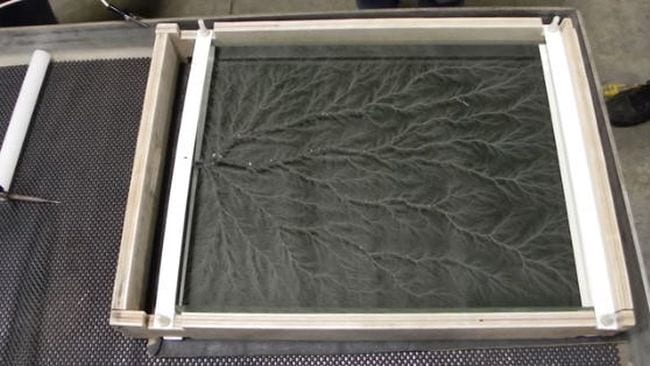
See electricity in action when you generate and capture a Lichtenberg figure with polyethylene sheets, wood, or even acrylic and toner. Change the electrical intensity and materials to see what types of patterns you can create.
Learn more: Lichtenberg Figure at Science Notes
Explore the power of friction with sticky note pads
Difficulty: Medium / Materials: Basic
Ever try to pull a piece of paper out of the middle of a big stack? It’s harder than you think it would be! That’s due to the power of friction. In this experiment, students interleave the sheets of two sticky note pads, then measure how much weight it takes to pull them apart. The results are astonishing!
Build a cloud chamber to prove background radiation
Ready to dip your toe into particle physics? Learn about background radiation and build a cloud chamber to prove the existence of muons.
Measure the effect of temperature on resistance
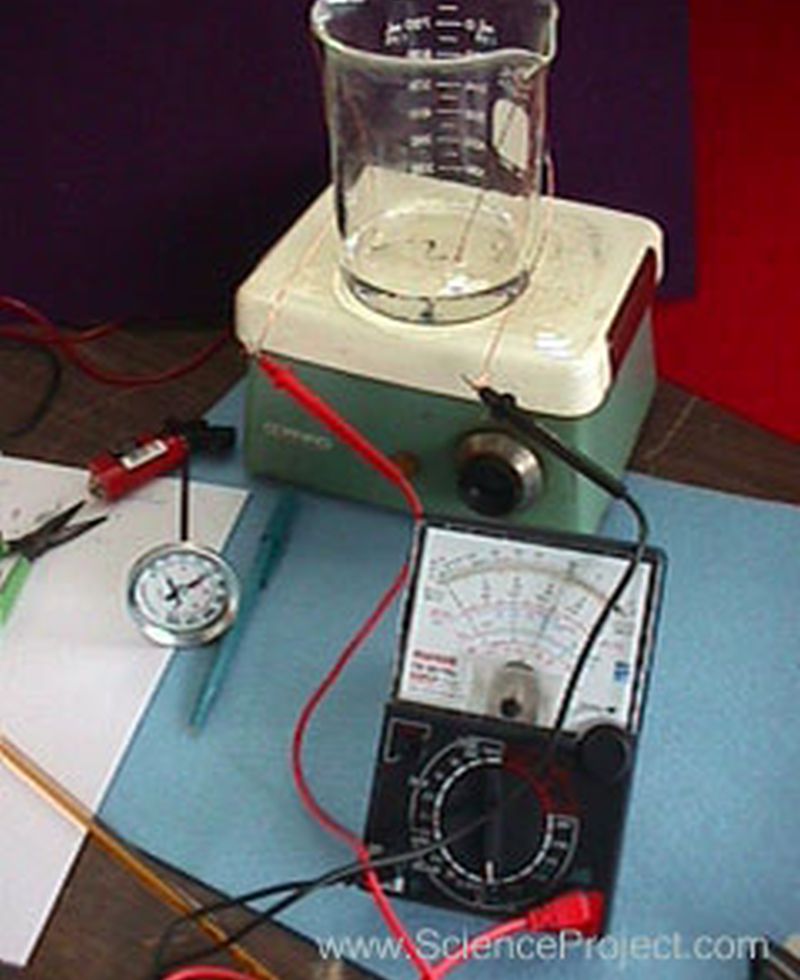
This is a popular and classic science fair experiment in physics. You’ll need a few specialized supplies, but they’re pretty easy to find.
Learn more: Temperature and Resistance at Science Project
Launch the best bottle rocket
A basic bottle rocket is pretty easy to build, but it opens the door to lots of different science fair projects. Design a powerful launcher, alter the rocket so it flies higher or farther, or use only recycled materials for your flyer.
More Physics Science Fair Projects for High School
Design your own experiment in response to these questions and prompts.
- Determine the most efficient solar panel design and placement.
- What’s the best way to eliminate friction between two objects?
- Explore the best methods of insulating an object against heat loss.
- What effect does temperature have on batteries when stored for long periods of time?
- Test the effects of magnets or electromagnetic fields on plants or other living organisms.
- Determine the best angle and speed of a bat swing in baseball.
- What’s the best way to soundproof an area or reduce noise produced by an item?
- Explore methods for reducing air resistance in automotive design.
- Use the concepts of torque and rotation to perfect a golf swing.
- Compare the strength and durability of various building materials.
Many schools are changing up their science fairs to STEM fairs, to encourage students with an interest in engineering to participate. Many great engineering science fair projects start with a STEM challenge, like those shown here. Use these ideas to spark a full-blown project to build something new and amazing!
Solve a current environmental issue
A science fair project can also be an entry into the Slingshot Challenge . Students produce a 1-minute video with a solution to a current environmental problem (think: uniting creative waste reducers on social media or rehabilitating forests affected by fire) for the chance to receive up to $10,000 in funding.
Construct a model maglev train
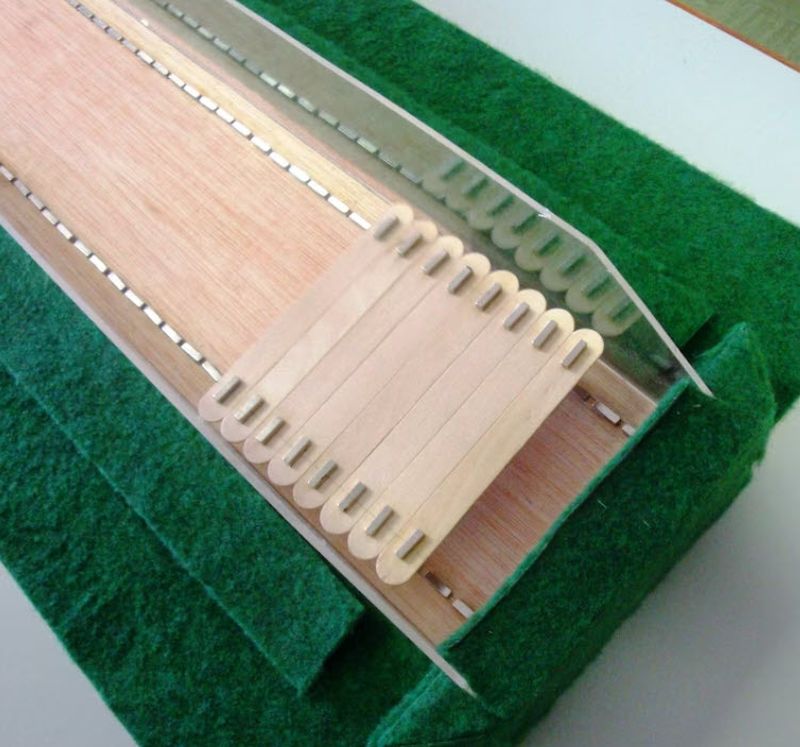
Maglev trains may just be the future of mass transportation. Build a model at home, and explore ways to implement the technology on a wider basis.
Learn more: Maglev Model Train at Supermagnete
Design a more efficient wind turbine
Wind energy is renewable, making it a good solution for the fossil fuel problem. For a smart science fair project, experiment to find the most efficient wind turbine design for a given situation.
Re-create Da Vinci’s flying machine
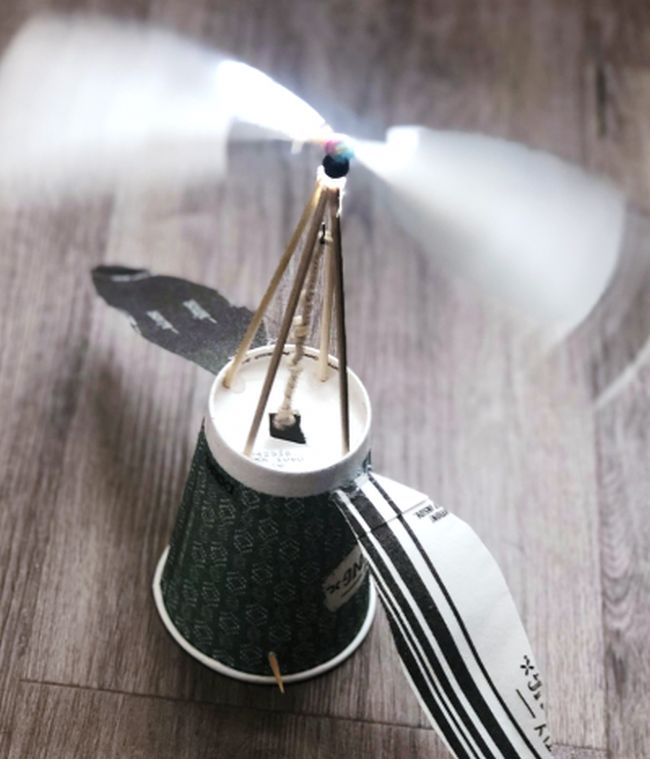
Da Vinci sketched several models of “flying machines” and hoped to soar through the sky. Do some research into his models and try to reconstruct one of your own.
Learn more: Da Vinci Flying Machine at Student Savvy
Design a heart-rate monitor
Smartwatches are ubiquitous these days, so pretty much anyone can wear a heart-rate monitor on their wrist. But do they work any better than one you can build yourself? Get the specialized items you need like the Arduino LilyPad Board on Amazon.
Race 3D printed cars
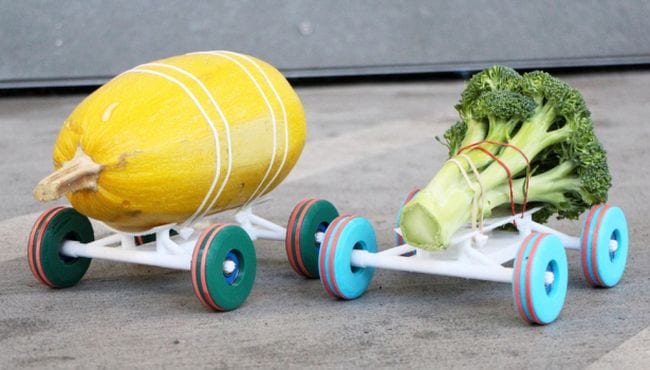
3D printers are a marvel of the modern era, and budding engineers should definitely learn to use them. Use Tinkercad or a similar program to design and print race cars that can support a defined weight, then see which can roll the fastest! (No 3D printer in your STEM lab? Check the local library. Many of them have 3D printers available for patrons to use.)
Learn more: 3D Printed Cars at Instructables
Grow veggies in a hydroponic garden
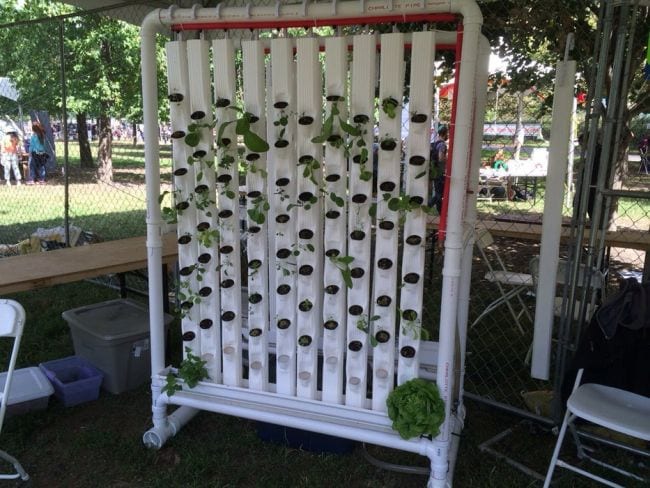
Hydroponics is the gardening wave of the future, making it easy to grow plants anywhere with minimal soil required. For a science fair STEM engineering challenge, design and construct your own hydroponic garden capable of growing vegetables to feed a family. This model is just one possible option.
Learn more: Hydroponics at Instructables
Grab items with a mechanical claw
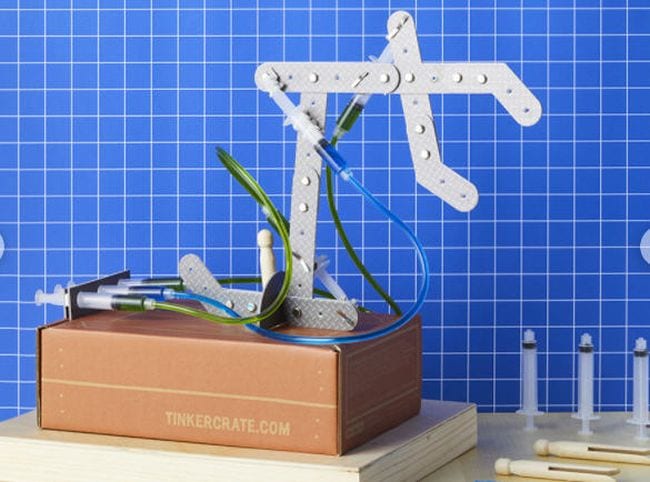
Delve into robotics with this engineering project. This kit includes all the materials you need, with complete video instructions. Once you’ve built the basic structure, tinker around with the design to improve its strength, accuracy, or other traits.
Learn more: Hydraulic Claw at KiwiCo
Construct a crystal radio
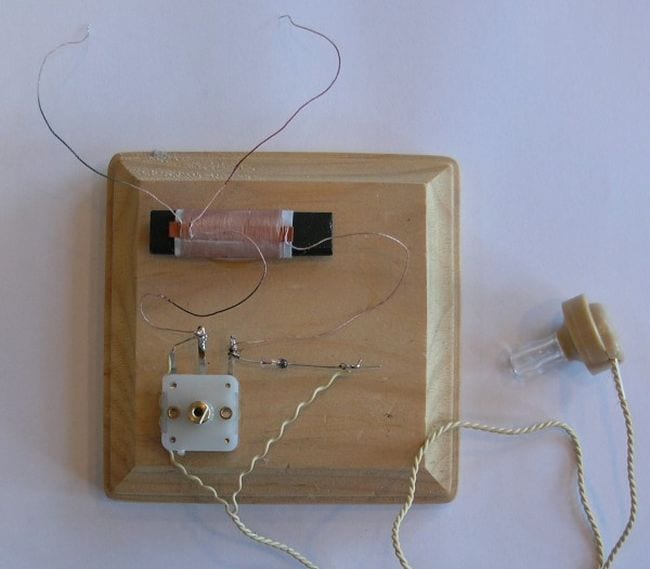
Return to the good old days and build a radio from scratch. This makes a cool science fair project if you experiment with different types of materials for the antenna. It takes some specialized equipment, but fortunately, Home Science Tools has an all-in-one kit for this project.
Learn more: Crystal Radio at Scitoys.com
Build a burglar alarm
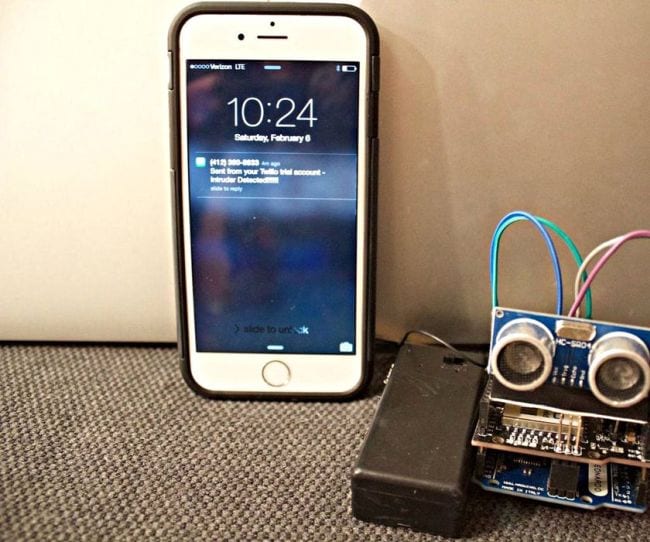
The challenge? Set up a system to alert you when someone has broken into your house or classroom. This can take any form students can dream up, and you can customize this STEM high school science experiment for multiple skill levels. Keep it simple with an alarm that makes a sound that can be heard from a specified distance. Or kick it up a notch and require the alarm system to send a notification to a cell phone, like the project at the link.
Learn more: Intruder Alarm at Instructables
Walk across a plastic bottle bridge
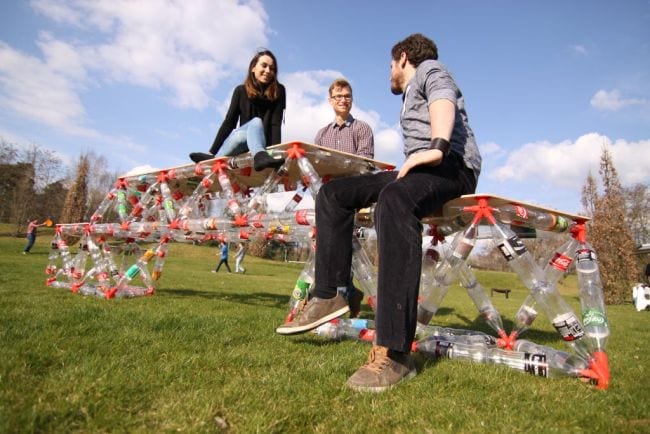
Balsa wood bridges are OK, but this plastic bottle bridge is really impressive! In fact, students can build all sorts of structures using the concept detailed at the link. It’s the ultimate upcycled STEM challenge!
Learn more: TrussFab Structures at Instructables
Looking for more science content? Check out the Best Science Websites for Middle and High School .
Plus, get all the latest teaching tips and tricks when you sign up for our newsletters .
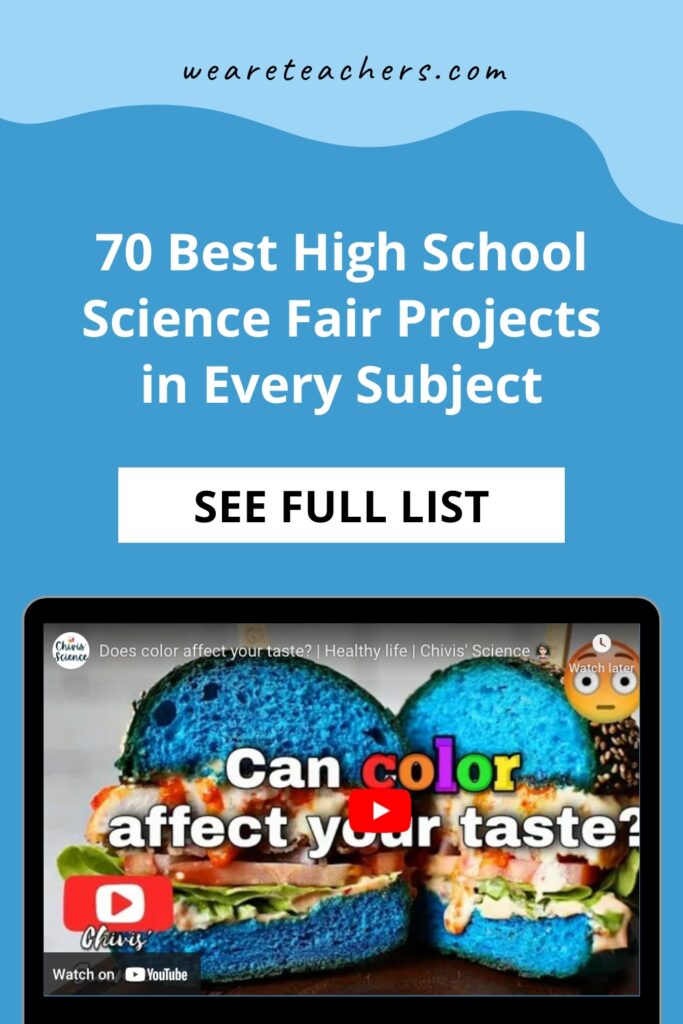
You Might Also Like
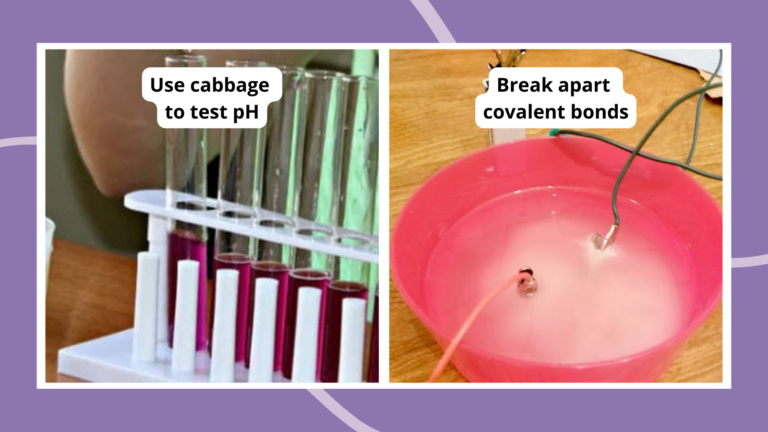
45 Cool Chemistry Experiments, Demos, and Science Fair Projects
Don't forget your safety equipment! Continue Reading
Copyright © 2024. All rights reserved. 5335 Gate Parkway, Jacksonville, FL 32256

IMAGES
COMMENTS
This research project aimed to evaluate the implementation of project-based learning (PBL) in the STEM Research curriculum of the Philippine Science High School-Luzon campuses.
Posted on August 30, 2019 August 30, 2019 by Philippine Science High School System. CAPPING OFF THIS YEAR'S SCIENCE RESEARCH SUMMIT, the PSHS System recognises the hard work and diligence of the scholars in conducting their researches. ... Project WaFLE: Development of an Arduino-based Water Flow and Level Encoder (Gonzaga, Hans; Adel, Jhoe ...
The student researches highlighted in this site have participated in at least one national research congress/fair. Stenochlaena palustris, locally called Barangbang, is a common vegetable in Northern Luzon (Philippines) yet little is recognized about its phytochemical and nutrient characteristics and its antimicrobial properties.
This is a collection of science fair research ideas and a showcase of Muntinlupa National High School students' investigatory projects, with the objective of promoting scientific research among the general public. The entire write-up for every project is NOT displayed for copyright purposes; only RANDOM parts of the project are shown instead. Further questions about the projects presented ...
STEM schools have put priority on establishing research education as a core program that enables students to choose a topic of their choice, identify a problem, and find a solution to it through experimentation and other modes of data collection. At the Philippine Science High Schools, one of its key goals is to foster a research culture among its scholars, who will help to strengthen the ...
This study aimed to determine the effects of integrating Project-based learning (PBL) on the Science Process Skills and 21st-Century Skills of Grade 11 students at Rizal High School in Pasig City during school year 2022-2023.The researcher used an explanatory sequential design with three phases and a triangulation approach in data analysis.
The Research Program of the Philippine Science High School Juanita M. Cruz Philippine Science High, Diliman. Quezon City, Philippines The Philippine Science High School (PSHS) is a special science hieh school entrusted with selecting and preparing gifted ~ i l i & n ostudents to enter careers in the scie&&. he PSHS is an attached agency of the Department of Science and Technology (DOST), the ...
DOST-PSHSS is the premier science high school in the Philippines where students are prepared for a career in science, technology, and mathematics (STEM). The two-year project, under the leadership of Ms. Jodi Mylene Lopez, aims to enhance the intellectual property (IP) and technology transfer system among the 16 PSHS campuses and enhance its ...
The National Institute of Physics (NIP) welcomes the opportunity to guide High School students in their Investigative Projects (IPs). The objective is to introduce young students to a refined view of science and provide them with meaningful experience. For this program, Doing Science for Science Sake, is an all encompassing theme.
In 1963, the Republic Act (R.A.) 3661 established the Philippine Science High School (PSHS) to offer a scholarship on secondary education with emphasis on science to prepare students for a science career. The first campus operated in Diliman, Quezon City. In 1998, by virtue of R.A. 8496, the PSHS System was created to harmonize the operations of four existing PSHS campuses: Diliman (now Main ...
The Philippine Science High School System (Filipino: Sistemang Mataas na Paaralang Pang-agham ng Pilipinas) is a research-oriented and specialized public high school system in the Philippines that operates as an attached agency of the Philippine Department of Science and Technology.PSHS is considered as the top science high school in the Philippines and is viewed to be among the best in the ...
If you have any concerns/inquiries, you may reach Raissa Ancheta at 0915-304-4422 or email [email protected]. Nine student groups from different parts of the country bagged research grants up to P800,000 each as the Department of Science and Technology - Philippine Council for Industry, Energy and Emerging Technology Research and ...
A cache of studies has delved into the use of project-based learning approaches in many academic courses but the research education. This research project aimed to evaluate the implementation of project-based learning (PBL) in the STEM Research curriculum of the Philippine Science High School - Luzon campuses. Select teachers from the ...
The eleventh episode of Agyamanak: Makabayang Iskolar Ako! program invites aspiring students throughout the region to be part of the Philippine Science High School (PSHS) community. One of the goals of the PSHS system is to mold one's character and development through science, technology, and innovation that has always been the top priority ...
Philippine Science High School-Cebu Village (PSHS-CV) will be presented and analyzed. ... This project won the top prize in The Bright Ideas Challenge (TBIC) organized by Shell in ... Research. 4 ...
Seventeen Grade 11 and 12 students from the Philippine Science High School (PSHS) CALABARZON Regional Campus, and one from PSHS Main Campus joined the second Science Immersion Program (SIP) hosted by the Philippine Council for Health Research and Development (PCHRD) through its Research and Development Management Division (RDMD).
the judges who will choose ten outstanding projects. This event will be participated by the same Grade 8 students who participated in the Camp and it is targetted to be held on November 2019, PSHS scholars Development of Homeroom modules based on Positive Education/Psycholo gv Philippine Science High School System (PSHSS) in cooperation with Unilab
The Philippine Science High School (PSHS) System presented its innovation initiatives and science education leadership practices in the virtual edition of the 2021 International Mother Language Conference and Festival on February 27. Executive Director Lilia T. Habacon, PSHS-Eastern Visayas Campus Director Erick John H. Marmol, and Executive Secretary Aries Oliveros discussed the distinct ...
Science investigatory projects (SIPs) are authentic tasks that science teachers implement in science curriculum. With this, the study investigated the journey of the secondary schools in SIP instruction through the lens of the teachers. Narrative inquiry from 12 purposively selected and interviewed science teachers/winning coaches from six schools in an SIP consistent winning Division in ...
Philippine Science High School (PSHS) System; Science Education Institute (SEI) Science and Technology Information Institute (STII) ... DOST will provide annual funding of up to Php 5,000,000 for each approved research project while MOST will provide an annual funding of up to RMB 1,000,000 for the Chinese counterpart. Each project should have ...
Physics High School Science Fair Projects. When you think of physics science projects for high school, the first thing that comes to mind is probably the classic build-a-bridge. But there are plenty of other ways for teens to get hands-on with physics concepts. Here are some to try. Remove the air in a DIY vacuum chamber Instructables